
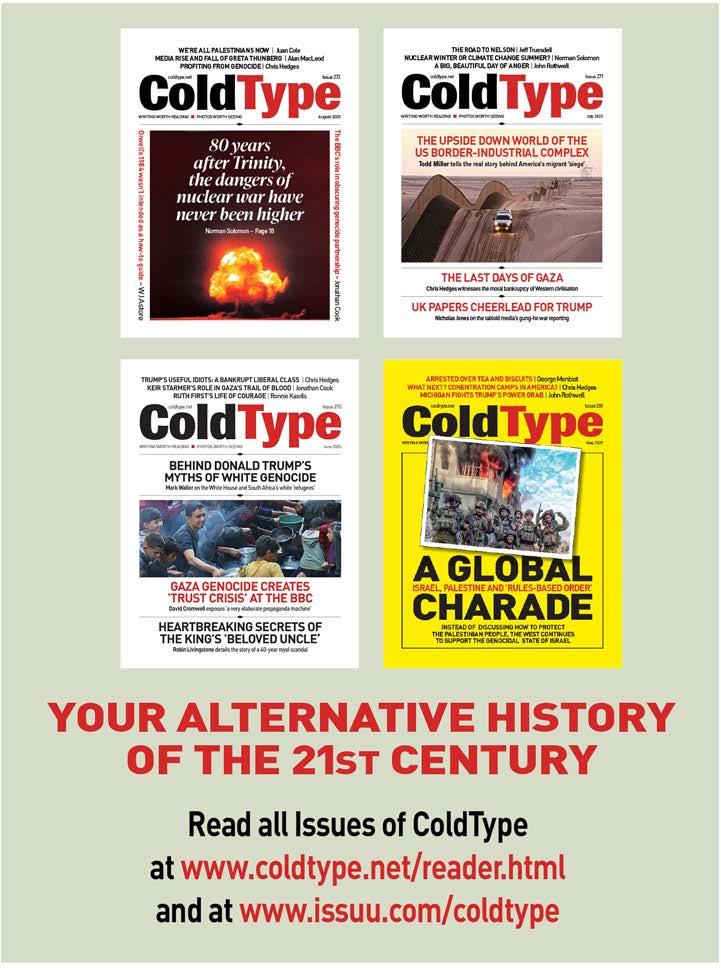



5 The farce behind the Nobel Peace Prize
Binoy Kampmark
7 The hole truth: Austerity costs us all a fortune
George Monbiot
8 Suddenly, it’s fat generals that are the problem!
William Astore
9 Greed At A Glance Equality.org
10 RFK threatens a century of medical progress
Sonali Kolhatkar
11 It’s up to Israel, not their victims, to end genocide
Caitlin Johnstone
12 The vicious cycle of US-Israel ‘peace’ ploys
Ramzy Baroud
13 Hurwitt’s Eye
Mark Hurwitt
7 Lewis Street, Georgetown, Ontario, Canada L7G 1E3
Contact: Tony Sutton editor@coldtype.net
Subscribe: For a FREE subscription e-mail editor@coldtype.net
Back Issues: www.coldtype.net/reader.html or www.issuu.com/coldtype
Disclaimer:
The contents of the articles in ColdType are the sole responsibility of the author(s). ColdType is not responsible for any inaccurate or incorrect statements they may contain
©ColdType 2025



The fuss about the Nobel Peace Prize has always been excessively outsized to its relevance. Like most prizes, the panel is bound to have its treasure trove of prejudices and eccentricities in reaching any decision. Thin resumes have swayed the Norwegian committee to acts of dottiness.
Surprising moments of dark humour have made an appearance in the award of the prize to warmongers and those antithetical to peace. And those on the Nobel Prize peace panel would barely cause a murmur of acknowledgement outside the spine-like length of that coun-
try of only 5.6 million inhabitants. (The current membership of five features, for instance, three politicians: Anne Enger, former leader of
the country’s Centre Party; former Conservative Party education minister Kristin Clement, and former state secretary of the Labour Party, Gary Larsen.)
Rather feebly, Asle Toje, another member of the five, uses a gastronomic metaphor in describing the selection process: “We do it pretty much the same way you make a good sauce – you reduce and reduce and reduce.” The reduction formula leads to surprising, rancid results. In 1973, the ruthless, toadying poseur Henry Kissinger was overcome with joy in receiving the prize. The National Security Adviser and US Secretary of State had
supposedly done much to advance the cause of peace in the Indochina conflict by “spearheading cease-fire negotiations” that led to an armistice in January 1973. His co-awardee, North Vietnamese negotiator Le Duc Tho, was far more sensible, refusing to accept a peace award where there was no peace to be had.
The choice of Kissinger was almost mockingly ghoulish. This was the same man who left his marks all over secret and illegal bombing campaigns in Laos and Cambodia during the Nixon administration, oversaw the extinction of democratically elected governments in Latin America in favour of murderous, authoritarian regimes, and spent his early academic career arguing that small-scale nuclear might be feasibly pursued by the United States as a psychological lever.
The selection for 2025 was always going to be shadowed by the theatre known as the Donald Trump show. In claiming not to want it, the US President has done much to pad out his credentials to make himself eligible. He has put on an incomplete, disputable show of halting conflicts while indulging in spells of violence (strikes on Venezuelan shipping, ostensibly carrying drugs to the US; the illegal bombing of Iran’s nuclear facilities).
What the committee has done is the next best (or worse) thing. In opting for María Corina Machado, seen as the main figure of the Venezuelan opposition to the current government of Nicolás Maduro, they have offered the prize to a Trump medium. “I dedicate this prize to the suffering people of Venezuela and to President Trump for
his decisive support in our cause,” she cooed on X.
Almost hinting at something in the works – that is to say, the ongoing regime change agenda so enthusiastically sought by Washington – Machado was convinced of being “on the threshold of victory and today, more than ever, we count on President Trump, the people of the United States, the peoples of Latin America, and the democratic nations of the world as our principal allies to achieve freedom and democracy.” Given Latin America’s record on peaceful transitions from coups, this was fine humour indeed.
The award to Machado was, according to the Nordic wiseacres, based on her “tireless work promoting democratic rights for the people of Venezuela and for her struggle to achieve a just and peaceful transition from dictatorship to democracy.”
They go on to be didactic, talking about democracy being in global retreat, with Machado being its illuminating defender. (On being barred from running, she installed the surrogate opposition leader Edmundo González who allegedly won the July 2024 election.)
This is the bromide of binary thought. Machado’s record, befitting most political records, is untidy. David Smilde, a student of Venezuelan politics, sees her as “a controversial pick, less a peace activist than a political operator willing to use some of the trade’s dark arts for the greater democratic good.” Even that might be generous.
For one thing, she is clearly biding her time, shunning local and regional elections, treating the honouring of the 2024 presidential election results as absolute. She has openly argued for the necessity of foreign in-
tervention in removing Maduro and endorsed Trump’s military buildup in the Caribbean, calling the recent bombing of suspected drug boats a matter of “saving lives”. To remove Maduro was essential, she argues, because of his alleged credentials as “the head of a narco-terrorist structure of cooperation.”
Disingenuously, she has swallowed the dubious theory that Maduro is the true figure running the Tren de Aragua gang, which Trump accuses of directing operations against the United States. Her Vente Venezuela party has enthusiastically shared the threats by US officials against supposed Venezuelan drug traffickers on X. “If you’re in the Caribbean,” states one recent post, “if you’re north of Venezuela and you’re trying to traffic drugs to the US, you’re a legitimate target for the US.”
Machado is undoubtedly readying herself to step into any presidential vacancy, forced or otherwise. She claims to have a plan for the first 100 hours and the first 100 days of a transition process, promising the generation of wealth for the country to the value of $1.7 trillion over 15 years. Her advisor on international affairs, Pedro Urruchurtu, has been open about communicating with the Trump administration over Maduro’s removal.
Again, this says much about the eccentric reading of peace embraced by the insular Norwegian grandees. If Tom Lehrer was right to call political satire obsolete after Kissinger’s award, it would also be accurate to say that instances of rich farce have come in its wake. CT
Binoy Kampmark lectures at RMIT University. He may be contacted at bkampmark@gmail.com
➤ GEORGE MONBIOT
Iwas lucky. Last week, I was cycling downhill at night when I hit a pothole. The front wheel folded into an infinity symbol. I went over the handlebars and, with no time to put my hands out, landed on my face. My helmet and glasses took most of the impact. I emerged, remarkably, with just a few cuts and bruises.
My glasses were banjaxed, my bike needed major repairs and my clothes were torn. Altogether, that pothole has cost me about £450. Again, I’m lucky – I can afford it. But the point is this: fixing a pothole costs us between £45 and £90. Not fixing it costs us far more.
God knows how many other people have pranged their bikes or wrecked their car tyres in the same hole. Between us, we may have paid hundreds of times the cost of its repair. If people have suffered significant injuries, so must the UK’s National Health Service. One of my correspondents tells me: “I’m three months into recovery from a cycling accident with a pothole that left me being airlifted to hospital with potentially life-threatening injuries. As well as a brain haemorrhage (despite a helmet), I had numerous broken bones and can’t yet walk without crutches.” The cost to the health service must be huge; the cost to him incalculable.
holes, alongside many other gaps in public provision, unfilled – does not save money. On the contrary, it costs us a fortune. What the rich might save in taxes, the rest must pay over and over again.
False economies abound. For example, the government may at last be persuaded to remove the Tories’ vicious, Malthusian two-child benefit cap. But what many people have failed to grasp is that behind it stands another brick wall: the household benefits cap. If families
cal authorities must provide at far greater expense: roughly £2.3bn a year. Being forced into temporary accommodation also curtails adults’ employment opportunities and children’s performance at school, and generates great suffering, which can translate into physical and mental health problems, which of course means further economic impacts.
In 2019, a parliamentary committee called on the government to “conduct a full cost benefit analysis of the benefit cap,” The government rejected the call, but said it would explore the possibility in future. I checked with the Department for Work and Pensions – it still hasn’t happened.

Austerity – which leaves our pot-
now receive money for a third child, it could push them past the household limit, and they’ll be scarcely better off than before. This household cap has extreme and perverse consequences. It ensures that rents, even in the social sector, are almost everywhere unaffordable to the families affected, most of which are headed by lone parents. The result is that they are thrown into temporary accommodation, which lo-
Keeping people in poverty is an expensive luxury. Poverty persists in rich countries because governments have made a political choice to keep people poor. This choice is driven by two imperatives. The first is a deep, ancient and irrational belief that poverty is a vice that must be punished. The second is the bosses’ need to keep us in a state of fear, so that people continue to perform stressful and demeaning work for lousy pay. Or take adult social care. Around 2 million elderly people are not receiving the care they need. Many younger adults who could work if they had sufficient care are unable to do so. Some 2.6 million people, mostly women, have given up paid work to care for family members, as there are no good alternatives. They lose an average of £5,800 in annual earnings, a vast aggregate
cost to the country.
Insufficient care drives many people into the arms of the NHS: at any one time, 13 percent of NHS beds are occupied by people waiting for social care support. Proper funding would provide a major economic boost, as good care requires a large workforce.
According to the Future Social Care Coalition, for every £1 invested in social care work, £1.75 is generated in the wider economy. But, as a parliamentary inquiry found, evidence of the costs of failing to provide sufficient care “is scandalously scant or even absent from decision making”. The government counts the costs of provision, but not the costs of non-provision.
The shortfall in government funding for social care has caused a financial crisis in almost every local authority. Other services are being cut to the bone. The potholes crisis, in other words, is a direct result of the social care crisis. In any exploration of the costs and benefits of social care spending, you could include the price of people being airlifted to hospital because the roads are falling apart.
Of course, we should be wary of reducing everything to a costbenefit analysis: many forms of necessary spending will carry a net cost to the Exchequer, which is the price we pay for living in a kind and decent society. But this should not prevent us from remarking on the utter perversity of counting only the costs of state spending, while ignoring the benefits.
The government, using a definition that means nothing to people falling into potholes, or into tempo-
rary accommodation, or into debt, insists austerity has ended, as there has been a slight, albeit temporary rise in public spending as a percentage of GDP. But when it leaves so many essential services underfunded, the technical definition becomes a sophisticated lie. A more honest definition of austerity is a decline in services caused by a shortfall in funding.
The bill for a crisis caused by the ultra-rich – the 2008 bank crash and the vast state bailout it triggered – has been handed to the poor. But that’s neither necessary nor inevitable. If Labour chose, the new budget could put us on an entirely different course, one in which we need not suffer smashed glasses, mangled bikes, broken bones, evictions, poverty and neglect, to allow the ultra-rich their private jets,
➤
powerboats, beauty spas and second, third or fourth homes. Either they carry the cost, through income tax, wealth tax and a much fairer council tax or property tax banding system, or everyone else carries a much higher one.
There would be a cost – a political cost – for the government in confronting the massive infrastructure of persuasion the very rich have built, and ending our 15-year sentence of austerity. But the cost of failing to do so, for all of us, is so much higher. CT
George Monbiot’s latest book, written with Peter Hutchinson, is Invisible Doctrine: The Secret History of Neoliberalism. His website is www.monbiot.com. This article first appeared in The Guardian
The military historian Dennis Showalter once told me that he didn’t care about the amount of fat around a general’s belly – he cared about the fat between a general’s ears. It was a telling quip, and one that highlights the shortsighted nature of Pete Hegseth’s emphasis on fitness and military bearing to the generals and admirals he assembled in California recently.
(By the way, what about Trump as commander-in-chief. Is he going to exercise and lose weight? Good luck with that one, Pomade Pete.)
Of course, physical fitness is important in military settings, especially if you’re at the pointy end of the spear, as they say in the military. But America’s senior leaders today are not “boy generals” like George Armstrong Custer in the US Civil War. They are men and women in their fifties and early sixties, presumably promoted for their integrity, knowledge, insight, skill, and experience, not because they can still run sub-six minute miles or perform 100 pushups.
Recall all the media praise showered on William Westmoreland, Da-
vid Petraeus, and Stanley McChrystal. These three generals were lauded for their physical fitness and military bearing, their “spartan” qualities as warriors. And they all demonstrated strategic mediocrity in fighting and losing the Vietnam, Afghan, and Iraq Wars. They may not have had flabby bellies, but they had flabby minds.
Hegseth is all about “warrior” image over substance. Don’t get me wrong: I think everyone should exercise if they can, and being substantially overweight isn’t healthy. When I was in my early forties and a lieutenant colonel, I ran with the troops and did pushups and sit ups. But there’s a lot more to military effectiveness than being “a lean mean fighting machine.”
But I’ll admit I’m burying the lede here. Trump and Hegseth’s message to senior leaders was far more disturbing than complaints about a fat and woke military. Here’s what I sent to a friend about this:
“The ‘national security’ state has kept our country in a state of permanent war since 1947. Trump and Hegseth are just ripping the facade of ‘security’ away and replacing it with ‘war.’
“‘Peace is the word that dare not speak its name. And “war,” of course, has come to the streets of America, with troops deployed to Portland next. Add that to the many police who got their initial training in the military and the rapid expansion of ICE along with detention centres and it’s obvious how the war on terror has truly become global since now the focus is on terror in America.
“We are reaping what we
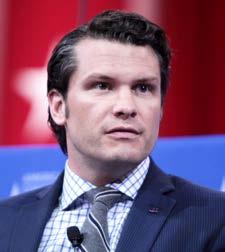
sowed…”
I was then asked for a more formal comment and came up with this: “The statements of Trump and Hegseth show that the “global” war on terror was and is truly global (as well as permanent) because that war has now come home to America’s cities. Now places like LA and Portland are to be pacified by American ‘warriors’ and warfighters, with detention centres (concen-
tration camps) for those who resist. President Dwight D. Eisenhower was never more right or prescient when he noted, ‘Only Americans can hurt America.’”
Trump and Hegseth see America’s streets as a battleground for the US military against “the enemy within.” The real enemy to democracy, of course, is the very deployment of troops to the streets. American colonists launched a revolution 250 years ago partly because they didn’t want the king’s troops among them as enforcers.
Anyone who doesn’t see the fundamental dangers of Trump and Hegseth’s actions to democracy and our Constitutional rights truly has some flab between their ears. CT
William J. Astore is a retired lieutenant colonel (USAF), professor of history, and a senior fellow at the Eisenhower Media Network (EMN), an organisation of critical veteran military and national security professionals. His website is www.bracingviews. com

➤ SONALI KOLHATKAR
Arguably the most important medical innovation of the 20th century is under attack, in part because it’s been so effective.
We live in an era when diseases such as polio are incredibly rare –because of childhood vaccines. Now, thanks to the antivaxxer-in-chief at the Department of Health and Human Services, Robert F. Kennedy Jr., we may be reentering the era of long-eradicated infectious diseases.
In a contentious Senate hearing in September, RFK tried to have it both ways on vaccines. He asserted that President Donald Trump deserved the Nobel prize for Operation Warp Speed, which yielded the COVID-19 vaccine in record time in late 2020. But he also claimed the vaccine didn’t work.
“Secretary Kennedy is all over the place,” said Dr. Robert Steinbrook, director of Public Citizen‘s Health Research Group and a Yale professor of medicine. “He contradicts himself, he says one thing, then he says the exact opposite. And then when he is caught on that, he deflects or goes in yet additional directions.”
The federal Advisory Committee on Immunization Practices (ACIP) has traditionally set nationwide recommendations on vaccines. But ACIP’s new configuration includes members hand-picked by RFK. And soon after the September hearing, the committee released weakened and confusing recommenda-
tions on COVID-19 and childhood vaccinations.
“This is no way to approach public health,” says Steinbrook.
For years, antivaxxers have been the bane of science-based medicine. By exploiting legitimate public suspicions of pharmaceutical companies, they have sowed enough doubt among Americans to make RFK appear reasonable in some quarters.

CONFUSING: Robert F. Kennedy, Jr
With President Donald Trump echoing RFK’s false information on vaccines and on medication as benign as acetaminophen, the charlatan heading HHS is causing even stalwart Republicans to waver. An unnamed GOP lawmaker told The Hill that their colleagues are “starting to break ranks” over RFK.
Still, how did an antivaxxer make it into one of the most important positions of medical power in the nation? In part, because Republican senators – including those who claim to take science-based medicine seriously – overrode their own
concerns to confirm him.
Take Senator Bill Cassidy (R-LA), who at the HHS Secretary’s Senate confirmation hearing last January blamed RFK in part for the growing numbers of parents eschewing vaccines for their children.
Cassidy, a physician and head of the Senate Health, Education, Labor, and Pensions Committee, was a key vote for RFK’s confirmation. The senator, who claims he extracted pro-vaccine promises from RFK as justification for his confirmation vote, appears to have sacrificed his own principles for politics.
According to Dr. Steinbrook, “a number of the Republican Senators did push back and voice support for vaccines. Of course, these senators also voted to confirm Secretary Kennedy.”
I’ve diligently vaccinated my own children. The shots ensure their safety in a way that wasn’t widely available to children a hundred years ago. But vaccines aren’t simply about individual choice, as antivaxxers might claim. Their effectiveness is based on herd immunity.
Unvaccinated people are far more likely to succumb to infectious diseases, as many people in low-income nations know first-hand. And the more vaccination rates fall, the more a disease can spread. The more people are exposed, the more likely they are to catch a disease, even if they are vaccinated.
Vaccines work best when almost everyone is vaccinated. It’s an act of collective care that we seem to have taken for granted, perhaps because large numbers of children aren’t dropping dead around us – as they did before vaccines.
Now, thanks to RFK and his growing army of antivaxxers, my children’s health and safety is at risk – as are everyone’s.
Thankfully, the American Academy of Pediatrics and state governments are stepping in to reassert the importance of vaccines. But RFK’s leadership has, in Dr. Steinbrook’s words, “put us in very much
➤ CAITLIN JOHNSTONE
uncharted territory for the future of public health in this country.” CT
Sonali Kolhatkar is host and executive producer of Rising Up With Sonali, an independent, subscriber-based syndicated TV and radio show. This article was distributed by www.otherwords.org
It’s never legitimate to withhold aid from starving civilians. It was never legitimate at any time.
That’s one of the annoying things about having to discuss Israel’s ridiculous claim that Hamas is hoarding hostage corpses in order to achieve some kind of goal, and therefore justifies reducing aid into Gaza as punishment: the conversation skates right over the fact that it has never been legitimate for Israel to withhold humanitarian aid into Gaza. Debating whether Israel is right or wrong to withhold aid under these specific circumstances tacitly assumes that it could ever be right to withhold aid under any circumstances.
Listening to Israel’s justifications for why it needs to inflict monstrous abuses upon the Palestinians has the effect of assuming that there are circumstances under which those monstrous abuses could be acceptable. And there just aren’t.
It has never been legitimate to intentionally deprive civilians of hu-

manitarian aid that they need to survive. You have to give them aid.
It has never been legitimate to shoot non-combatants because you decided they crossed some sort of line into a forbidden zone. It has never been legitimate to shoot noncombatants at all.
It has never been legitimate to commit genocide. Israel just needs to stop the genocide.
The onus for stopping a genocide is on the party committing the genocide. The onus is not on the victims of the genocide to end it by meeting certain conditions. This should not even need to be said. It’s so obnoxious how everyone’s
getting sucked into these debates about whether or not Israel might need to resume the genocide because Hamas refused to disarm or they didn’t get their hostage corpses back or this or that ceasefire demand wasn’t met or blah blah whatever. Israel has never needed to commit genocide. It needs to stop committing genocide.
The world shouldn’t be bending over backwards to ensure that the state which is committing genocide is happy with the terms by which the genocide is ended. The world should be aggressively punishing the state that is committing genocide until it stops. That would be true peace. What we are seeing now is just a bad joke.
And of course this true peace is not emerging because the powerful western states who’ve been backing the genocide this whole time are perfectly fine with it. Their weapons industries get to profit from the genocide. Their empire managers get to enjoy the domination of a critical geostrategic region. They sleep like babies at night, because they do not view the victims of the genocide as human beings.
So we find ourselves doing this ridiculous dance where we go “Okay well maybe the genocide could stop if the victims of the genocide agree to terms X, Y and Z and don’t make too much of a fuss about being killed in smaller numbers every day.” This is madness. It’s the craziest thing you could possibly imagine. We live in a dystopian madhouse. CT
Caitlin Johnstone is an Australian independent journalist. This article was first published at her web site, www. caitlinjohnstone.com.au
➤ RAMZY BAROUD
The history of Zionism is fundamentally one of deception. This assertion is critically relevant today, as it contextualises the so-called “Trump Gaza proposal,” which appears to be little more than a veiled strategy to defeat the Palestinians and facilitate the ethnic cleansing of a significant portion of Gaza’s population.
Since the start of the current conflict, the United States has been Israel’s staunchest ally, going as far as framing the outright slaughter of Palestinian civilians as Israel’s “right to defend itself.” This position is defined by the wholesale criminalisation of all Palestinians – civilians and combatants, women, children, and men alike.
Any naive hope that the Trump administration might restrain Israel proved unfounded. Both the Democratic administration of Joe Biden and the Republican administration of his successor have been enthusiastic partners in Israeli Prime Minister Benjamin Netanyahu’s messianic mission. The difference has been primarily rhetorical. While Biden wraps his staunch support in liberal discourse, Trump is more direct, using the language of overt threats.
Both administrations pursued strategies to hand Netanyahu a victory, even when his war failed to achieve its strategic objectives. Biden used his Secretary of State,
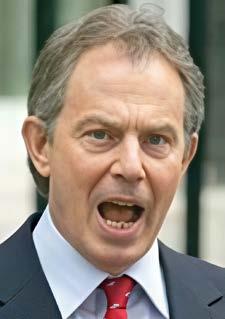
Antony Blinken, as an emissary to broker a ceasefire fully tailored to Israeli priorities. Similarly, Trump utilised his son-in-law Jared Kushner and former British Prime Minister Tony Blair, among others, to concoct a parallel ploy.
Netanyahu deftly exploited both administrations. The Trump era, however, saw the US lobby and Israel seemingly dictating American foreign policy.
A clear sign of this dynamic was the famous scene last April, during Netanyahu’s White House visit, when the “America First” President pulled out a chair for him. The summoning of Blair, who once headed the US-controlled Quar-
tet for Peace, to the White House alongside Kushner in August, was another foreboding signal. It was evident that Israel and the US were planning a much larger scheme, not only to crush Gaza but to prevent any attempt at resurrecting the Palestinian cause altogether.
While ten countries were declaring recognition of the state of Palestine to applause at the UN General Assembly between September 21 and 23, the US and Israel were preparing to reveal their grand strategy, with critical contributions from Ron Dermer, then Israel’s Minister of Strategic Affairs.
The Trump Gaza proposal was announced on September 29. Almost immediately, several countries, including strong supporters of Palestine, declared their backing. This support was given without realising that the latest iteration of the plan was substantially altered from what had been discussed between Trump and representatives of the Arab and Muslim world in New York on September 24.
Trump announced that the proposal was accepted by Israel and threatened Hamas that, if it does not accept it within “three or four days,” then “it’s going to be a very sad end.” Still, UN Secretary-General Antonio Guterres, who, along with the UN, has largely failed to hold Israel accountable, declared his support for the Trump proposal, stating that “it is now crucial that all parties commit to an agreement and its implementation.”
Netanyahu felt a newfound elation, believing the weight of international pressure was finally lifting, and the onus was shifting to
the Palestinians. He reportedly said that “now the whole world, including the Arab and Muslim world, is pressuring Hamas to accept the conditions.”
Comfortable that the pendulum had swung in his favour, he openly restated his objectives in Gaza on September 30: “To release all our hostages, both the living and the deceased, while the IDF remains in most of the Strip.”
Even when Arab and Muslim nations protested the amendments to the initial Trump plan, neither Netanyahu nor Trump relented, the former continuing the massacres, while the latter repeating his threats.
The implication is stark: regardless of the Palestinian position, Israel will continue to push for the ethnic cleansing of the Strip using both military and non-military means. The plan envisions Gaza and the West Bank being administered as two separate entities, with the Strip falling under the direct control of Trump’s so-called “Board of Peace,” thus effectively turning Blair and Kushner into the new colonial rulers of Palestine.
History is most critical here, particularly the history of Israeli deception. From its onset, Zionist colonialism justified its rule over Palestine based on a series of fabrications: that European settlers held essential historical links to the land; the erroneous claim that Palestine was a “land without a people;” the assertion that indigenous natives were intruders; and the stereotype that Arabs are inherently anti-Semitic. Consequently, the state of Israel, built on ethnically cleansed Palestinian land,
was falsely marketed as a ‘beacon’ of peace and democracy.
This web of falsehoods deepened and became more accentuated after every massacre and war. When Israel faltered in managing its military efforts or its propaganda war, the United States invariably intervened. A prime example is the Israeli invasion of Lebanon in 1982, where a “peace deal” was imposed on the PLO under US pressure. Thanks to US envoy Philip Habib’s efforts, Palestinian fighters left Beirut for exile, on the understanding that this step would spare thousands of civilian lives.
Tragically, the opposite occurred, directly paving the way for the Sabra and Shatila massacre and a prolonged Israeli occupation of Lebanon until 2000.
This historical pattern is repeating itself in Gaza today, though the
➤ HURWITT’S EYE
options are now more stark. Palestinians face a choice between the guaranteed defeat of Gaza – accompanied by a non-guaranteed, temporary slowdown of the genocide – and the continuation of mass slaughter. Unlike the Israeli deception in Lebanon four decades ago, however, Netanyahu makes no effort to mask his vile intentions this time. Will the world allow him to get away with this deception and genocide?
CT
Ramzy Baroud is a journalist, author and the editor of the Palestine Chronicle. His forthcoming book, Before the Flood, will be published by Seven Stories Press. Baroud is a Non-resident Senior Research Fellow at the Center for Islam and Global Affairs (CIGA). His website is www.ramzybaroud.net
MARK HURWITT
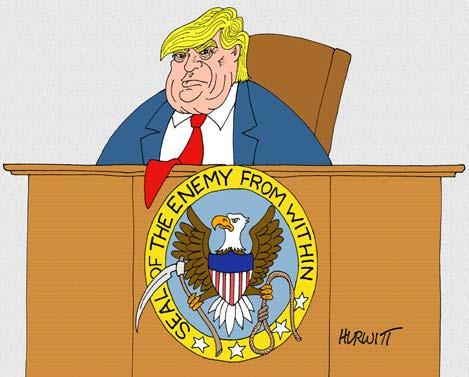
➤ TOM ENGELHARDT
America’s would-be King Donald is out on the golf course (again) as millions of citizens take part in mass protests against his power grab
Yes, in the ever more ominously unsettled (dis-) United States of Donald J. Trump, I recently went to the “hate America” rally in New York City. Or at least that’s what Republican Speaker of the House of Representatives Mike Johnson insisted it was. Who knew that so unbelievably many Americans, millions of us across the United States, would “hate” this country enough to go out and march in the recent No Kings demonstrations, even in places where we might have feared being in distinct danger from the troops of “our” president?
In the days before the latest No Kings demonstrations, no matter whom I talked to or where they lived, they seemed to be planning to go to their local version of that march/rally. My neighbours, other city people, suburbanites, even friends living in the countryside. And despite the people I knew who had marched in the first round of No Kings rallies, as I did, that wasn’t true then. This time, just about everybody turned out, or so it seemed!
Oh, wait! I suddenly thought of someone who wasn’t there. Oops, let me take that back. He was there, he just didn’t know it. He was on sign after sign after sign, doing this, doing that, doing the inconceivable – or do I mean, sadly
enough, the all-too-conceivable?
Take this one that I copied down, for example:
“Tyrant Rapist Usurper Madman Pedophile”
And I’m sure you know just what the first letters of those five words spell out!
“Only Butterflies Should Become Monarchs”
For me, that march began not at 50th Street and Seventh Avenue where I came out of the subway, but at the subway platform uptown where I was waiting to get on a train to the march. I suddenly noticed that the elderly woman (and I say that advisedly as an elderly man) standing next to me was carrying a handmade sign – the first of literally thousands I would see that day – that said, “No dictators/no kings” and, when I asked her about it, she promptly replied, “I would have called Trump a cunt, but he lacks the depth and warmth.”
Ifinally made it off that subway train with literally hundreds of other soon-to-be protesters and ever so slowly managed to make my way up the packed stairs onto an instant-
ly packed Seventh Avenue at the edge of New York’s Times Square. At least as far as I could tell, President Trump wasn’t there himself, preparing to march down Seventh Avenue in his old hometown of New York City with staggering numbers of other New Yorkers and me. News reports, based on police estimates, suggested that “more than 100,000” of us in my hometown and “nearly seven million” Americans in “more than 2,700” demonstrations nationwide actively protested – and when it comes to anti-Trump demonstrations, those doing the figures never exaggerate but almost invariably underestimate. (All I can tell you is that it was a stunning vista, with protesters, unbelievable numbers of whom carried homemade signs, literally packing the streets in a rally that would stretch from 47th Street to 14th Street with no space to spare.)
And yet, though he wasn’t in New York that day, it isn’t that Donald Trump never appears anywhere. In fact, only the previous Saturday, I’d actually (almost) seen him. I was visiting an old friend in Washington, DC, and we were taking a walk along a canal that leads to the Potomac River when suddenly we came upon a man with an elaborate camera on a stand and began chatting. He was, it turned out, working for a TV news network and his camera

was pointed at an extended grassy area across the Potomac, which, he told us, was a golf course. At that very moment, it seemed, America’s king – oops, sorry, Donald Trump – was evidently playing a round of golf there and the cameraman was waiting for him to make it to the seventh hole, which, he said, was right where we were then looking. Hey, and it was a relief to know that Donald Trump, just two years younger than me, was outdoors, too. As it happens, in my 81-plus years on this planet, I’ve only been
on a golf course once in my life. Still, on that recent trip, I was indeed nearly in the presence of “our” president who, on the weekend of the No Kings demonstrations, was at his Mar-a-Lago resort in Florida for a $1 million-a-plate dinner and undoubtedly playing golf again. And on that more recent Saturday, when I took that long walk (or, in terms of pacing, more like a crawl) down Seventh Avenue in his former hometown, from 47th street to 14th street, with – or so it seemed to me – a trillion other New Yorkers, I felt as if I
were again in “his” presence, given all the fantastic handmade signs people were carrying, which said things like: “Only butterflies should become Monarchs” (with, of course, an image of the president on it).
Or how about the two women in those dinosaur costumes with signs that said: “Eat the Tyrant,” “Eat the Oligarchs”? Or the poster that said “King of Fools” or, for that matter, the one that had “Kings belong in fairy tales, not government” scrawled on it. And here are just a few of the others I scribbled down
(something I could have done steadily for hours without ever coming close to copying them all): “Hey, Donald! George called and he’s pissed” (with an image of George Washington); “Keep your tiny hands off our Constitution” (with two tiny hands sketched on the sign); “No crowns for clowns” (with a drawing of Trump with a crown flipping off his head); and there were endless signs that had yellow king’s crowns with lines slashed through them. Or what about “King of Fools”? There were also a remarkable number with swastikas on them, while the phrase “the Turd Reich” was distinctly popular.
And don’t forget the woman carrying a sign that read, “The Pilgrims were undocumented.” Then there was that little girl with a handmade sign of her own that said, “The President shouldn’t bully,” while her mother carried one reading, “May I please remind you that it does not say RSVP on the Statue of Liberty.” Oh, and don’t forget “Grab ’em by the Epstein files,” “No Kings since 1776,” “Put Trump on ICE” (or “I prefer my ICE crushed” or “Fight climate change, send ICE to Antarctica”), “The American revolution was the first No Kings rally!!,” “We don’t bow to billionaires,” “No Fuhrers!” (with a swastika crossed out), and from a White man of a certain age, “My Dad Fought Fascism, too!” (And yes, I asked, and his father, like mine, did indeed fight in the Second World War.)
The United States seems to have a future that’s anything but bright, however low the president’s approval ratings may sink
And then there was a Hispanic protester carrying a sign that said (movingly), “I’m using my one Saturday off to be here. #No Kings.” And don’t forget that image of an umbrella with the words, “I can’t stand the reign.”
of power away from Congress and, worse yet, he’s been itching to use the US military, the National Guard, and ICE agents, however haphazardly, in cities with Democratic mayors whom he obviously dislikes. And that’s something, if it finally happens, that no American since the Civil War has ever had to experience. Of course, he’s already asked the Supreme Court to permit him to federalise state National Guard troops and send them into Democratic cities to support his immigration enforcement and mass deportation plans.

Mind you, since more or less every other person was carrying a sign of some sort, there were literally thousands more of them, mostly handmade. Meanwhile, as we walked, chants like “No KKK, No Fascist USA, No ICE!,” “This is what Democracy looks like!,” “What do we want? Trump out! When do we want it? Now!” rang out constantly. The march was so big that, when I finally made it to 14th Street, my son, who had come to the rally later than me, was still at 42nd Street on a wide avenue still utterly packed with marchers. And consider all of this, nationwide, a reminder that, despite what Donald Trump may think, this is no longer his America in a country where a genuine majority of us “disapprove” of him in the latest polls and – best guess –more of us will do so in the months to come.
Sadly, as many of the signs at that rally suggested, this country seems to have a future that’s anything but bright, however low the president’s approval ratings may sink. (They’ve more or less levelled off for now, but don’t expect that to last.) And yes, he clearly does have the urge, whatever Americans may or may not approve of, to rule as the equivalent of a king. He and his key officials have already taken a significant amount
November 2025 | www.coldtype.net
While it’s all still experimental (if such a word can even be used for it), from the Caribbean Sea to Chicago, President Trump and his crew seem intent on militarising and –if such a word can even be created – authoritarianising the world he (more or less) rules over. Certainly, immigration raids are growing ever more militarised with, in one recent case, masked US law enforcement agents armed with rifles “rappelling from a Black Hawk helicopter and swarming [a] 130-unit building in Chicago.” As that city’s mayor, Brandon Johnson, would say afterward, “This raid wasn’t about public safety. It was certainly not about immigration. This was about a show of authoritarianism, a forceful display of tyranny.”
And mind you, we’re not quite a year into Donald Trump’s second term in office. Under the circumstances, three more years could prove a long, long time for him and his crew to be able to do their damnedest, or perhaps even literally crown him as the first American king. After all, back in February, he had already posted an image of himself at Truth Social with a king’s crown on. Only recently (and all too ominously), in response to
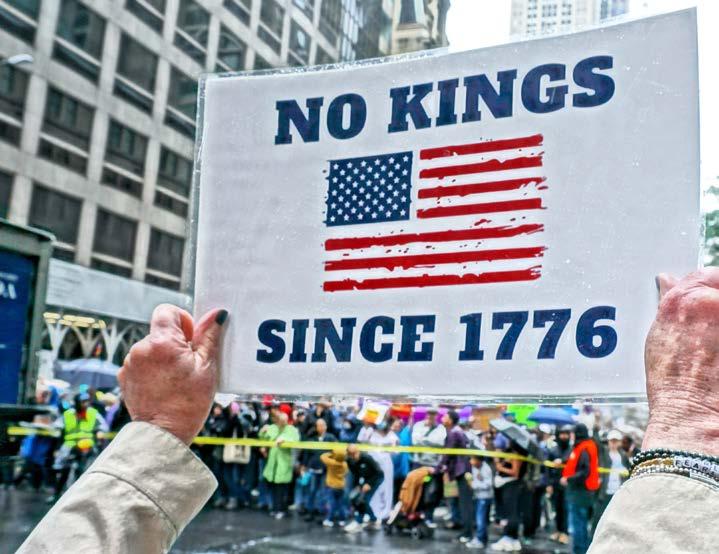
the No Kings demonstrations, he posted a fake AI video of himself wearing a king’s crown and flying a fighter plane (with “King Trump” emblazoned on it) over what’s probably Times Square in New York City filled with protestors and dropping what’s clearly a bomb-load of literal crap on them.
Soon after that, he reposted another AI-generated video that Vice-President JD Vance had put up (with the song Hail to the King by the heavy metal band Avenged Sevenfold in the background). In it, he crowns himself and then unsheathes a sword, while those in front of him, including former Speaker of the House of Represent-
atives Nancy Pelosi and Senate minority leader Chuck Schumer, go down on their knees and bow their heads to him.
The question, of course, is: How long before such AI-generated fake videos might indeed become an eerie Trump- and Vance-generated version of reality? After all, in the wake of the recent congressional shutdown, we’ve found ourselves in a political world in which Congress functionally no longer seems to exist.
In some sense, everything is now being Trumped (or perhaps that should be put in capital letters:
TRUMPED). It will certainly be (ominously) interesting to see just how long he can both trample on and Trumple on the American people. Think of him as golfing while Rome burns. CT
Tom Engelhardt created and runs the website TomDispatch.com. He is also a co-founder of the American Empire Project and the author of a highly praised history of American triumphalism in the Cold War, The End of Victory Culture. A fellow of the Type Media Center, his sixth book is A Nation Unmade by War. This article was originally published at www.tomdispatch.com
➤ LINDA PENTZ GUNTER
From terrifying the children of immigrants to pepper-spraying frogs, the US under Trump is rapidly descending into mayhem
An inflatable frog has been pepper-sprayed, spawning (sorry) an army of affinity frogs and other creatures real and fictional, protesting at the often violent arrests of immigrants. A clarinettist in a brass band has been assaulted and arrested, abbreviations have been outlawed and naked bicycle riders are swarming our streets.
If it looks like the United States has gone mad, that’s because it probably has.
All of this happened in just one US city – Portland, Oregon – the hotbed of antifa, according to the Trump administration, which is trying to proscribe the “group” even though these days “antifa,” an abbreviation of “anti-fascist,” pretty much defines anyone who opposes Trump, and was never an actual organisation.
Also, the US Secretary of Defence, who – in the interests of achieving peace – says he has renamed his purview the Department of War, although no-one actually calls it that, announced in early October that the United States had given the Qataris their own air force base in Idaho.
DoD Secretary Pete Hegseth’s bizarre declaration was quickly retracted after President Trump’s own “America First” base reacted with shock that a foreign power was
being gifted its own military base on American soil. What Hegseth apparently meant, or what he now says he meant it to mean, is that the US will be hosting the Qatari military on a US base for training purposes, a not uncommon practice.
In another ominous move by the DoD, this time to shut down free speech, the department has ordered media outlets that cover the Pentagon to sign onto a new press policy that forbids defence reporters from soliciting, obtaining or using any information not already authorised by the DoD. All but one have refused to do so.
Meanwhile, as the Gaza ceasefire agreement was finally announced, Jared Kushner, the reprehensible son-in-law of the even more repulsive US president, floating in some parallel universe and with visions of beachfront real estate still dancing in his head, publicly pronounced Israel “exceptional” for refusing to replicate “the barbarism of the enemy.”
Kushner seems not only to have missed the two-year genocide in Gaza but also Israel’s cruel and inhumane treatment of Palestinians for many decades prior.
He is not alone, of course. The
US mainstream media has been awash in happy reunion stories of the returned Israeli hostages, which would be entirely understandable if they did not at the same time largely ignore the grimmer realties surrounding the simultaneous release of the Palestinian hostages (for such they are, not “prisoners,” since most have never committed a crime).
Some of the Palestinians just released were never reunited with their families at all but were instead immediately deported to Egypt. Others were left in the West Bank where the hostile and violent takeover of Palestinian lands and homes by illegal Israeli “settlers” continues.
Even those who could joyously reunite with their loved ones, in some cases after decades of separation, were not allowed to savour that moment without the spectre of the Israeli menace still literally hanging over their heads.
Instead of bombs falling from the skies, the Israelis rained down threats in the form of paper messages warning Palestinians that “We are watching you everywhere. If you show any support for a terrorist group, you will expose yourself to arrest and punishment.”
No-one should believe that this ceasefire signals any intent whatsoever by Israel to relinquish its con-

trol over the lives of Palestinians.
The obvious response to all this? Give Trump the Nobel Peace Prize! The past weeks have seen a non-stop sycophantic advocacy campaign by legions of leaders and political commentators who advocated for Trump with almost unprecedented zeal. That was before the announcement of the decidedly problematic choice of Venezuelan opposition leader and “iron lady” Maria Corina Machado instead.
That is the paradigm we are now in: the belief that the Nobel Peace Prize should be awarded to those who enabled, funded, armed and participated in a genocide, once they themselves decided to halt their own war crimes.
Trump could have ended Israel’s genocide in Gaza on day one of his presidency with a single phone call to Israeli Prime Minister Benjamin Netanyahu. He chose not to. Like us, he watched the killings, bombings,
and forced starvation along with the targeted assassinations of 1,700 doctors and more than 200 journalists, live-streamed on our screens for two years. We’ve been horrified. He did nothing. Worse still, at times he egged on Netanyahu to “finish the job.”
Back home, Trump continues with his quiet coup. Denied for now the possibility of sending troops into major US cities, he will continue testing this, with an eye to deploying them during the 2026 midterm elections that could see both the US House and Senate swing to the Democrats.
Federal agencies are being purged of dissenters and stacked with “yes men.” The Elon Chainsaw Massacre may be over now that billionaire Elon Musk, who ordered the early rounds of dismissals through the entity he invented – the Department of Government Efficiency –has fled the scene. But the maiming continues, as critical workers are fired, public institutions defunded and non-profits viewed as progressive or “woke” are blacklisted.
The barbarity of the Immigration and Customs Enforcement (ICE) activities has prompted citizen protests and sometimes even interventions in cities across the US. Portland has become the epicentre of street theatre protest. The resistance began, as it often does, with a single individual, a man in an inflatable frog costume who goes by the name of Apollo Toad, staring down ICE (Immigration & Customs Enforcement) agents. Soon, others rallied to his side, dressed as a variety of animals and cartoon characters, at once mocking the proceedings, but at the same time driving home the absurdity of Trump’s attempt to label them terrorists.
The Portland clarinettist, Oriana Korol, had been playing music with
the Unpresidented Brass Band before she was knocked down according to eyewitnesses, then grabbed and taken to a jail in the neighbouring state of Washington to face charges of assaulting a federal agent, accusations her bandmates say are trump(et)ed up.
In Florida, far-right Governor and Trump acolyte Ron DeSantis is trying to get a Bill passed in his state’s legislature, HB 119, also known as the “No Sharia Act,” a fear-mongering attempt to “stigmatise Muslims by pretending that US courts could be ‘overruled’ by foreign or religious law,” the Council on American-Islamic Relations, a grassroots civil rights and advocacy group, said in a statement.
“In reality, American courts are already bound by the US Constitution’s Supremacy Clause, making HB 119 completely unnecessary and clearly unconstitutional,” the group said.
Black Hawk helicopters have descended on Chicago, frightening children out of their beds in the middle of the night, dragged naked and handcuffed with their families Gestapo-style out onto the street before being driven away in unmarked cars.
Ironically, one of the most banned books in America right now is A Clockwork Orange that features a
We are still clinging to the hope that our legal system will save us from autocracy and a descent into fascism
dystopian, violence-filled future. It’s a black comedy, but the censors miss that.
In the meantime, there were 44,000 gun deaths in the US in 2024, equivalent to wiping out an entire British town the size of Salisbury or Ashton-under-Lyne.
The Trump administration has banned or cautioned against using at least 350 words or phrases, including “climate change” (with and without a hyphen), “evidence-based,” “chest-feed + person” (don’t ask), “wind power” and yes, even “women.”
On the international front, Trump is bombing boats out of Venezuelan waters without a care as to who might be on them, leading to concerns of a war against Venezuela. He has also announced he may send long-range Tomahawk cruise missiles to Ukraine, a clear provoca-
tion to Russia.
At home, renewable energy projects have been all but killed off. Trump has threatened 100 per cent tariffs against China. The price of eggs has become the least of our problems.
There are still 190 active lawsuits challenging Trump administration actions, down from more than 300 since Trump took office in January which already seems like a lifetime ago.
We are still clinging to the hope that our legal system will save us from autocracy and a descent into fascism, even though the US Supreme Court is stacked in Trump’s favour. Three of the nine justices were placed there by him alongside three other arch-conservatives. It was that court that declared last year that the president has widespread immunity from prosecution while in office.
The government is still shut down. Trump says he won’t go to heaven (in case anyone cares), for achieving the Gaza ceasefire. But he is determined to plunge the country he is supposed to be leading into a living hell. CT
Linda Pentz Gunter is a writer based in Takoma Park, Maryland. This article was first published in Britain’s Morning Star newspaper
A

AMY WERBEL
In the first year of President Donald Trump’s second term in office, his administration has made many attempts to suppress speech it disfavours – at universities, on the airwaves, in public school classrooms, in museums, at protests and even in lawyer’s offices.
If past is prologue, these efforts may backfire.
In 2018, I published my book Lust on Trial: Censorship and the Rise of American Obscenity in the Age of Anthony Comstock. A devout evangelical Christian, Comstock hoped to use the powers of the government to impose moral standards
on American expression in the late19th and early-20th centuries. He and like-minded donors established the New York Society for the Suppression of Vice, which successfully lobbied for the creation of the first federal anti-obscenity laws with enforcement provisions.
Later appointed inspector for the Post Office Department, Comstock fought to abolish whatever he deemed blasphemous and sinful: birth control, abortion aids and information about sexual health, along with certain art, books and newspapers. Federal and state laws gave him the power to order law enforcement to seize these materials
and have prosecutors bring criminal indictments.
I analysed thousands of these censorship cases to assess their legal and cultural outcomes. I found that, over time, Comstock’s censorship regime did lead to a rise in selfcensorship, confiscations and prosecutions. However, it also inspired greater support for free speech and due process.
One effect of Comstock’s censorship campaigns: The materials and speech he disfavoured often made headlines, putting them on the public’s radar as a kind of “forbidden fruit.”
For example, prosecutions target-
ing artwork featuring nude subjects led to both sensational media coverage and a boom in the popularity of nudes on everything from soap advertisements and cigar boxes to photographs and sculptures.
Meanwhile, entrepreneurs of racy forms of entertainment – promoters of belly dancing, publishers of erotic postcards and producers of “living pictures,” which were exhibitions of seminude actors posing as classical statuary – all benefited from Comstock’s complaints. If Comstock wanted it shut down, the public often assumed that it was fun and trendy.
In 1891, Comstock became irate when a young female author proposed paying him to attack her book and “seize a few copies” to “get the newspapers to notice it.” And in October 1906, Comstock threatened to shut down an exhibition of models performing athletic exercises wearing form-fitting union suits. Twenty thousand people showed up to Madison Square Garden for the exhibition – far more than the venue could hold at the time.
The Trump administration’s recent efforts to get comedian Jimmy Kimmel off the air have similarly backfired.
Kimmel had generated controversy for comments he made on his late-night talk show in the wake of conservative activist Charlie Kirk’s assassination. ABC, which is owned by The Walt Disney Co., initially acquiesced to pressure from Federal Communications Commission Chairman Brendan Carr and announced the show’s “indefinite” suspension. But many viewers, angered over the company’s capitulation, cancelled their subscriptions of Disney streaming services. This led to a 3.3percent drop in Disney’s share price, which spurred legal ac-
Comstock became irate when a female author proposed paying him to attack her book and “seize a few copies” to “get the newspapers to notice it”
tions by shareholders of the publicly traded company.
ABC soon lifted the suspension. Kimmel returned, drawing 6.26 million live viewers – more than four times his normal audience – while over 26 million viewers watched Kimmel’s return monologue on social media. Since then, all network affiliates have resumed airing “Jimmy Kimmel Live!”
In the US, disfavoured political speech and obscenity are different in important ways. The Supreme Court has held that the First Amendment provides broad protections for political expression, whereas speech deemed to be obscene is illegal.
Despite this fundamental difference, social and cultural forces can make it difficult to clearly discern protected and unprotected speech.
In Comstock’s case, the public was happy to see truly explicit pornography removed from circulation. But their own definition of what was “obscene” – and, therefore, criminally liable – was much narrower.
In 1905, Comstock attempted to shut down a theatrical performance of George Bernard Shaw’s “Mrs. Warren’s Profession” because the plot included prostitution. The aging censor was widely ridiculed and became a “laughing stock,” according to the New York Times. Shaw went on to coin the term “Comstockery,” which caught on as a shorthand for overreaching censoriousness.
In a similar manner, when Attorney General Pam Bondi recently threatened Americans that the De-
partment of Justice “will absolutely … go after you, if you are targeting anyone with hate speech,” a swift backlash ensued.
Numerous Supreme Court rulings have held that hate speech is constitutionally protected. However, those in power can threaten opponents with punishment even when their speech clearly does not fall within one of the rare exceptions to the First Amendment protection for political speech.
Doing so carries risks.
The old saying “people in glass houses shouldn’t throw stones” also applies to censors: The public holds them to higher standards, lest they be exposed as hypocrites.
For critics of the Trump administration, it was jarring to see officials outraged about “hate speech,” only to hear the President announce, at Charlie Kirk’s memorial, “I hate my opponents, and I don’t want the best for them.”
In Comstock’s case, defendants and their attorneys routinely noted that Comstock had seen more illicit materials than any man in the US Criticising Comstock in 1882, Unitarian minister Octavius Brooks Frothingham quoted Shakespeare: “Who is so virtuous as to be allowed to forbid the distribution of cakes and ale?”
In other words, if you’re going to try to enforce moral standards, you better make sure you’re beyond reproach.
Comstock’s censorship campaign, though self-defeating in the long run, nonetheless caused enormous suffering, just as many people today are suffering from calls to fire and harass those whose viewpoints are legal, but disliked by the Trump administration.
Comstock prosecuted women’s rights advocate Ida Craddock for circulating literature that advocated for female sexual pleasure. After Craddock was convicted in 1902,
she died by suicide. She left behind a “letter to the public,” in which she accused Comstock of violating her rights to freedom of religion and speech.
During Craddock’s trial, the jury hadn’t been permitted to see her writings; they were deemed “too harmful.” Incensed by these violations of the First and Fourth amendments, defence attorneys rallied together and were joined by a new coalition in the support of Americans’ constitutional rights. Lincoln Ste ens of the nascent Free Speech League wrote, in response to Craddock’s suicide, that “those who believe in the general principle of free speech must make their point by supporting it for some extreme cause. Advocating free speech only
During Craddock’s trial, the jury hadn’t been permitted to see her writings; they were deemed “too harmful”
for a popular or uncontroversial position would not convey the breadth of the principle.”
Then, as now, the cause of free expression can bring together disparate political factions.
In the wake of the Kimmel saga, many conservative Republicans came out to support the same civil liberties also advocated by liberal Hollywood actors. Two-thirds
of Americans in a September 2025 YouGov poll said that it was “unacceptable for government to pressure broadcasters to remove shows it disagrees with.”
My conclusion from studying the 43-year career of America’s most prolific censor? Government ocials may think a campaign of suppression and fear will silence their opponents, but these threats could end up being the biggest impediment to their e ort to remake American culture. CT
Amy Werbel is Professor of the History of Art, Fashion Institute of Technology (FIT) in New York City. This article was first published at the Conversation – www.theconversation.com







LONDON
Photographs: Dougie Wallace – www.dougiewallace.com

Photographer Dougie Wallace
From the first lager-dripping chorus of Wonderwall to the arms aloft chanting of Don’t Look
Back in Anger, adoring crowds at the Oasis UK reunion concerts in London, Edinburgh and Dublin in July and August were united by a band whose brash attitude once defined a generation.
WEMBLEY STADIUM, LONDON – Decades after Oasis first swaggered onto the international stage before its self-destruction at the hands of feuding brothers Liam and Noel Gallagher in 2009, their ever-loyal fans displayed an unshakable belief in the redemptive power of rock and roll, keeping the glory days alive, one anthem at a time.
For five glorious days at a packed Wembley Stadium bucket hats were worn low, a nod to Liam Gallagh-
er’s trademark look, while zipped-up parkas and retro football tops signalled a revival of an aesthetic born in Manchester’s swaggering nineties heyday. Sunglasses remained compulsory, while vintage Adidas trainers scuffed along the concrete, badges of authenticity in a crowd where credibility still depends on the right brand and the right attitude.
And don’t forget the lager – a quarter of a million pints are poured each night of the Wembley performances at Wembley, easily eclipsing the 120,000 served during Coldplay’s 2024 run and leaving Taylor Swift’s Eras Tour figure of 40,000 in the dust. Beers airborne, bucket hats bobbing in time, this isn’t just a gig, it’s religion – and frontman Liam Gallagher, is their God.
MURRAYFIELD, EDINBURGH – The approach to





Murrayfield Stadium is a steady tide of parkas and flags, moving in from all directions. August brought 40 mph winds and rain that flattened bucket hats. Stone Island patches flashed at tram stops amongst retro football tops.
Fans swapped stories with strangers and eyed each other’s gear for signs of authenticity. A sprinkling of Norwegian flags, Welsh scarves and Italian football tops showed how far some of them had travelled.
Alcohol was on sale throughout the stadium and fans could drink at their seats. And for most of the fans left outside it felt like the old days of drinking at a football cup final.
It was a look forged in the pubs and terraces of nineties Britain, resurrected now – depending who you asked or how old you are – with

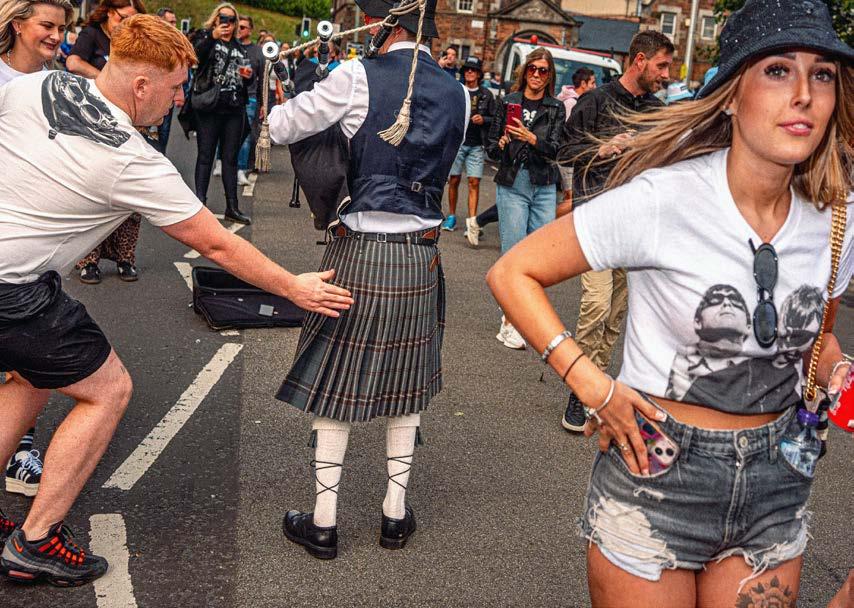

ironic flair or entirely without irony. Either way, it has been adopted by a new generation who came to see Liam Gallagher – ‘What the fk’s goin’ on in Edinburgh? All this jugglers and sword swallowing shit. Load of ’fing bollocks’ – turn it all into an open-air theatre.
It was the final night of the threeshow run, and Edinburgh stayed warm long after the sun dipped, the air sitting in the low twenties. Beer gardens around Roseburn were still busy as the last fans made their way in. The heat gave it more of a summer festival feel than a wet Scottish gig.
By the tram station steps, ticket-less fans gathered, perched on the railings listening to the rumble from inside.
In a year when politics seemed to

pit young against old, city against town, left against right, the Murrayfield crowd was a rare exception –Whatever their politics or accents, they were on the same side.
CROKE PARK, DUBLIN – The whole place is running like a pop-up high street, pubs spilling onto pavements, lager foam and burger smoke in the air.
Oasis fans came over on the ferries, turning the Holyhead crossing into a floating karaoke bar. Others piled off the Belfast train, a slow river of fans with cans, scarves and stories. Coaches waited at Dublin port, shuttling them straight to Drumcondra pubs where the pints were already lined up. By the time the turnstiles opened at Croke Park,



the city felt less like a tour stop and more like a pilgrimage. Reviews framed it as cathartic and jubilant. Gardaí praised the crowd and a drone show lit up Drumcondra.
SAME AGAIN! Liam’s voice is the best it’s been in years., the band is still together, denying the media the split it had been gleefully expecting. Now, rumours suggest that Knebworth will be the epicentre of next year’s shows, with extra dates in Newcastle, Manchester, Glasgow and even Paris’s Stade de France. Oasis have been reborn – and it seems they are here to stay. CT
Dougie Wallace is a London-based photographer. His website is www.dougiewallace.com
➤ DAVID EDWARDS
We live in a time when truth is reversed in plain sight. Black is declared white, and white is declared purple with pink polka dots. Immunity appears to be assumed on the basis that a sufficient proportion of the screenaddled population are too gullible or distracted to notice.
Thus, continuing the Nobel Committee’s ignoble tradition of awarding its Peace Prize to celebrity warmongers – think Theodore Roosevelt, Henry Kissinger and Barack Obama – this year’s award has been handed to Maria Corina Machado, leader of oil-rich Venezuela’s opposition. Max Blumenthal supplied some context:
“Machado is a US govt-funded regime change activist who’s helped lead failed military coups, violent street riots, and has likely promised her country’s oil and mineral wealth to a consortium of MAGA aligned billionaires in exchange for financing her political arsonism. This icon
of peace has even appealed to Benjamin Netanyahu to help her lead a military invasion of Venezuela.”
US fossil fuel executives, unfairly restricted to stealing oil from Iraq, Libya and Syria, are doubtless hoping the award will have a political effect in Venezuela comparable to that achieved by Alfred Nobel when he mixed nitroglycerine with diatomaceous earth to invent dynamite.
Competition for this year’s Peace Prize was fierce. Time magazine’s cover greeted the latest pause in Israel’s US-armed genocide in Gaza with a portrait of self-proclaimed Nobel front-runner Donald Trump: “HIS TRIUMPH”
The reference was to Trump’s Gaza Peace Plan that called for a ceasefire, commencing October 10, and the release of all 48 living and dead Israeli “hostages,” and 250 Palestinian “prisoners” in Israeli jails, as well as 1,718 detainees from Gaza.
For those of us fresh from seeing Palestinian fathers carrying their headless babies and starving children blown apart by Israeli bombs,

Time’s cover left our intelligence not just insulted but ground into the dirt. As the Roman historian Tacitus said: “They make a desolation, and they call it peace.”
Even Tacitus might have blanched at someone calling the desolation a “TRIUMPH.” After all, according to Emeritus Professor Paul Rogers at the University of Bradford, Israel’s blitz of Gaza using Trump’s bombs is “equivalent to six Hiroshimas.”
Washington’s naked emperor, the American Caesar, celebrated in the Israeli Knesset on October 13 in the presence of his friend “Bibi” Netanyahu. Amid much laughter and mutual backslapping, Trump declaimed:“We make the best weapons in the world, and we’ve got a lot of them. And we’ve given a lot to Israel, frankly.
“I mean, Bibi would call me so many times, ‘Can you get me this weapon, that weapon, that weapon?’

Some of them I never heard of, Bibi, and I made them. But we’d get them here, wouldn’t we, huh? And they are the best. They are the best.
“But you used them well. It also takes people that know how to use them, and you obviously used them very well. But so many, that Israel became strong and powerful, which, ultimately, led to peace. That’s what led to peace.”
As with Trump’s assertion that climate change is “the greatest con job ever perpetrated on the world,” responding to such a comment risks giving the impression that rational engagement might be possible. As an aphorism commonly misattributed to Mark Twain observes: “The truth has no defence against a fool determined to believe a lie.”
If we think the vision of a triumphant Trump and a heroic Israel that “obviously” used US weapons “very well” are confined to the crazed margins, take a look at Big Brother’s close relative, Auntie Beeb – the
BBC. We know, of course, that corporate journalists reserve a special use of language for Israel. ITV reported that an Israeli soldier had been “kidnapped from a tank during a battle with Hamas fighters.” By the same logic, 91,000 German soldiers were “kidnapped” by Soviet forces after the Battle of Stalingrad.
It is deemed similarly uncontroversial to describe Israeli captives as “hostages” and Palestinian captives as “prisoners,” even in the same news report, as in this example from the BBC: “It’s been a busy few days, with the release of dozens of Israeli hostages and thousands of Palestinian prisoners and detainees…”
We, of course, understand that the two-year ordeal of the 20 Israeli prisoners released as part of Trump’s “deal” was horrendous – worsened by the high probability of being killed by their own army. Any feeling person must welcome and celebrate their release from suffering. But if that empathy is prioritised above
compassion for the thousands of Palestinian prisoners, including many children, and the hundreds of thousands of Palestinians killed in Israel’s genocide, and the traumatised survivors trying to live amid the rubble, then our moral compass has been distorted, corrupted by the malign influence of prejudice and power.
And yet, for the BBC, Trump’s “ceasefire” was all about the 48 Israeli prisoners. Just imagine if Palestine had razed the whole of Israel to the ground, killing hundreds of thousands, injuring and traumatising literally millions and the BBC made the return of 20 Palestinian captives their continuous, highest profile focus.
In image after image, the BBC made the release of Israeli prisoners the big, emotive news story at the top of their homepage.
Continuously, on the day the captives were released, as well as on preceding and subsequent days, pictures of Israeli suffering and celebra-
tion were headlined exactly as if the British Broadcasting Corporation was the Israeli Broadcasting Corporation. By contrast, a single, small box was consistently reserved for news on the release of the much larger number of Palestinian prisoners. See here, here and here.
Even after the living Israeli prisoners had been released, the BBC headlined three dead Israeli prisoners with names, pictures and family background as their top news story, something it had not done for living Palestinian prisoners that had been released.
Are we a bit odd? Is it, in fact, obvious that the Israeli prisoners were the real news for reasons we don’t understand? If so, we are not alone, because the Guardian homepage managed to headline a picture of celebrating Palestinians as its top story.
The BBC published a long article detailing the names, pictures (repeated) and backgrounds of all 48 Israeli prisoners, thus deeply humanising them as individuals: “Who are the released hostages?” Compare that with this 55-second video: “Watch: Palestinian prisoners released in West Bank to rapturous crowds.” As usual, Palestinians are presented as an anonymous crowd –no humanising names, faces or personal stories.
The point is that the BBC was working as hard to humanise the Israeli captives as if they had been British. But why is it so crucial for the British public to focus so intensively on the fate of just these foreign captives, and why do the Palestinian captives matter so much less? The reality, of course, is that the BBC is trying hard to rehabilitate the devastated reputation of Israel, a key USUK ally.
A day later, the Financial Times reported: “Israeli soldiers killed several Palestinians in northern Gaza on Tuesday, a day after US President Donald Trump touted the end of the
Why does the BBC focus so intensively on the fate of just the Israeli captives, and why do the Palestinian captives matter so much less?
war in the coastal enclave.”
This breaking of the ceasefire was reported in a rolling BBC live report, but it was not headlined on the BBC homepage. Middle East coverage on the BBC News website is overseen by online Middle East editor Raffi Berg. We wrote to Berg on X: “Good morning, @raffiberg. Why didn’t we see a headline of this kind on the BBC website yesterday?”
We, of course, received no reply. In December 2024, the Guardian’s Owen Jones wrote on Drop Site News of the same Raffi Berg: “On August 23, 2020, Berg posted an image of Israel’s Prime Minister Benjamin Netanyahu taking a phone call at his desk. In his post, Berg has zoomed in on and circled a copy of [Berg’s book] Red Sea Spies visible on a bookshelf behind the prime minister. “First time I’ve been on a prime minister’s bookshelf!” he wrote. “I know I’ve got one of #Israel PM @netanyahu’s books on mine –but wow!” He tweeted a similar image in January 2021.”
A former BBC journalist told Jones of Berg: “This guy’s entire job is to water down everything that’s too critical of Israel.”
On October 16, Reuters reported Hamas’s claims that Israeli had killed at least 24 Palestinians since the ceasefire started. The following day, this Associated Press headline certainly belongs in our Hall of Propaganda Infamy: “Israel strikes southern Gaza in test of ceasefire.”
Israel breaking the ceasefire was merely a “test” of the ceasefire, even though the report itself confirmed that “at least 36 Palestinians were killed across Gaza, including children.”
With Time magazine celebrating, Trump and “Bibi” chuckling over a job well-done, with the media trying to convince us that Israeli “hostages” matter infinitely more than Palestinian “prisoners,” it is a challenge to hang on to our sanity and sense of what is right. It may help to remind ourselves of the true extent of the genocide that these people are celebrating and whitewashing.
In an article titled, “Skewering History – The Odious Politics of Counting Gaza’s Dead,” Dr Richard Hil, Adjunct Professor in the School of Human Services and Social Work at Griffith University and Dr Gideon Polya, formerly a biochemist at La Trobe University, reviewed the evidence.
They noted that, according to figures issued by the Palestinian Ministry of Health in early May 2025, the official death toll in Gaza since October 7, 2023 had been over 55,000, with more than half of the dead being women and children.
Hil and Polya noted that while widely regarded as credible, the Ministry’s data had been challenged in the Lancet by an international team of epidemiological researchers who in February 2025 put the death toll in Gaza at 64,260. Using this approach, the Lancet authors argued that “the Palestinian Ministry of Health under-reported mortality by 41%. Women, children and older people accounted for just under 60 per cent of the 28,257 deaths.” (Our emphasis)
Hil and Polya commented: “Importantly, the researchers argued that the actual death toll was likely much higher given the exclusion of non-trauma deaths resulting from the destruction of health care facili-
ties, food insecurity, and lack water and sanitation.”
A subsequent letter published in the Lancet reported a “conservative estimate of four indirect deaths per one direct death” in Gaza. (Rasha Khatib, Martin McKee, Salim Yusuf, “Counting the dead in Gaza: difficult but essential,” the Lancet, July 2024) Hil and Polya commented on this assertion: “Assuming that deaths from deprivation were four times the violent deaths, then the 136,000 violent deaths after 15.5 months of killing (April 25, 2025) would imply 544,000 Gaza deaths from imposed deprivation, and that the total Gazan death toll would accordingly be 136,000 violent deaths plus 544,000 from imposed deprivation, leading to a staggering total of 680,000 deaths by April 25, 2025. Most of these victims, as indicated in earlier counts by the Ministry of Health are women and children.”
They added: “Assuming that 33 per cent of the violent Gaza deaths were children, 21 per cent women and 46 per cent, men (according to the Euro-Med Human Rights Monitor), and that the same proportions obtain for the deprivation-based deaths of noninfant children, women and men, then the 680,000 Gazans killed by violence and imposed deprivation by 25 April 2025 included about 380,000 under-five-year-old infants, 479,000 children in total, 63,000 women and 138,000 men.’
Readers may recall that at the time of the Iraq war, it was widely reported that around 100,000 Iraqis had been violently killed. But Lancet researchers, and others, again found that the actual death toll from nontrauma deaths was far higher, likely more than one million.
If that is the true, unbearable scale of what has been wrought by Israel on the captive population of
“Damn the ignorant, lavishly paid, cruel, canting newspaper columnists and studio hosts. Damn the knownothing reporters …”
Gaza, what is the truth of British responsibility?
Peter Oborne has worked as political editor of the Spectator, as chief political commentator of the Daily Telegraph, as a journalist at the Evening Standard and as a commentator at the Express. He has made nearly 30 documentaries for Channel 4, BBC World and BBC Radio 4, appeared endlessly on highprofile radio and TV programmes, and has been made Society of Editors Press Awards Columnist of the Year.
But in his new book, Complicit – Britain’s Role in the Destruction of Gaza (OR Books, 2025) – Oborne has arguably transcended all of these achievements. In the conclusion to his book, this vanishingly rare example of a media insider turned truth-teller comments of Britain: “We bear a heavy responsibility for the deaths in Gaza, third in line only behind Israel and its primary patron and collaborator the United States. We helped enable the daily slaughter, destruction, disease, starvation, and human misery. We could have stopped arms sales. We could have sanctioned Israel. We could have ended military support.” (e-book version, p.195)
In an extraordinary concluding section to a book that strips away any last remaining illusions that Britain has an honest and honourable free press, Oborne writes:
“Damn the politicians and journalists who never reported on or cared about the deaths of Palestinian journalists targeted and killed
by Israel. Damn the blood-soaked British newspaper industry. Damn you Murdoch. Damn you Rebekah Brooks. Damn you Victoria Newton, editor of the Sun. Damn you Tony Gallagher. You are the Times editor who awarded space to Yoav Gallant, wanted by the ICC for alleged war crimes including the use of starvation as a weapon of war and crimes against humanity. Damn you Professor Niall Ferguson for co-writing that article.
“Damn you Chris Evans, editor of the Daily Telegraph, for turning your newspaper into one of Israel’s propaganda tools. Damn you Zanny Minton Beddoes of the Economist. You allowed your renowned journal to denounce the International Court of Justice genocide judgment as a “show trial.” You knew that Israel was turning Gaza into a “hellscape” yet still demanded: “fight on.”
“Damn you Daily Mail editor Ted Verity and your offshore proprietor Lord Rothermere. Damn you Michael Gove. Damn the Spectator
“Damn the ignorant, lavishly paid, cruel, canting newspaper columnists and studio hosts. Damn the know-nothing reporters who peddled lies and twisted the facts. Damn the reporters who were too afraid to search out the truth…
“Damn the moral cowards at the top of the BBC: Samir Shah, Robbie Gibb, Tim Davie, Richard Burgess. Damn you for failing to understand the meaning of the great institution you have disgraced, or why it mattered so much.” (p.196)
This is just a sample from Complicit. Oborne has much more to say in what is undoubtedly one of the most important exposés of the British press we have read. CT David Edwards is co-editor of Medialens – www.medialens. org – where this article was first published. He is the author of A Short Book About Ego
➤ JONATHAN COOK
The legal and ethical earthquake from Israel’s carnage in Gaza was never going to be contained there. As the Aston Villa football row shows, the shockwaves for Britain will keep growing louder
No one should be surprised that British Prime Minister Keir Starmer confected yet another duplicitous antisemitism furore last month –one in which he implicitly cast West Midlands Police as colluding in Jew hatred and insisted that British Muslims be exposed to racist violence from visiting foreign football hooligans.
Starmer had demanded that a decision by the police to bar fans of an Israeli club, Maccabi Tel Aviv, from attending a Europa League match in Birmingham this month be overturned.
He indicated that the West Midlands force had approved the ban on the grounds that hatred towards Jews in Britain had reached such fever pitch that police could no longer guarantee the Israeli fans’ safety from antisemitic violence.
His reasoning defamed both the British public and the police. The media lost no time in amplifying his narrative.
But Starmer’s claims were pure disinformation – as he surely knew from the police intelligence reports that must have been submitted to him before he called for the ban to be reversed.
Sadly for Starmer, those assess-
ments were leaked to the media. They show that West Midlands Police made the decision after receiving reports from Dutch police that Maccabi fans had instigated racist violence in Amsterdam last year – before, during and after a match with local team Ajax.
As one source with inside knowledge of the police assessments told the Guardian: “The biggest risk was always the extreme Maccabi fans who want to fight.” It had taken 5,000 Dutch police officers three days to bring the violence to an end.
The likely cost of policing this month’s Aston Villa game was estimated at least £6m (US$8m), and would have required the deployment of large numbers of specialist riot squads from across the UK.
Not unreasonably, the police concluded that giving licence to Israeli football hooligans seeking to make good on chants of “Death to Arabs” in an ethnically diverse city like Birmingham was a bad idea.
According to the assessment, even members of the Jewish community opposed letting Maccabi fans attend. Many of the Israeli club’s hardcore supporters – those that attend away fixtures – are like-
ly to be current or reserve soldiers who have participated in the Gaza genocide. They deserve arrest, not the UK rolling out the red carpet.
But strangely, Starmer did not see it this way. In his eyes, it seems, foreign thugs and war criminals should enjoy greater privileges in Britain than local ethnic minorities. Maccabi hooligans’ right to bring their genocidal incitement and violence to the UK trumps the right of minorities to be protected.
What political advantage his advisers thought he would gain is hard to grasp. Starmer simply added yet more fuel to Britain’s race relations fires – by smearing, once again, Muslims as antisemitic and “unBritish.” The only beneficiary will be Nigel Farage’s Reform party.
So what on earth is going on?
In normal circumstances, this kind of behaviour from a government whose polling figures are in freefall – and whose traditional urban heartlands are deserting it –would look like self-sabotage. But these are not normal times.
Starmer knows that US President Donald Trump’s “peace plan” has done nothing more than slow Israel’s genocide, and that the so-called “ceasefire,” which Israel is violating on a daily basis, will crumble sooner or later – more likely sooner.
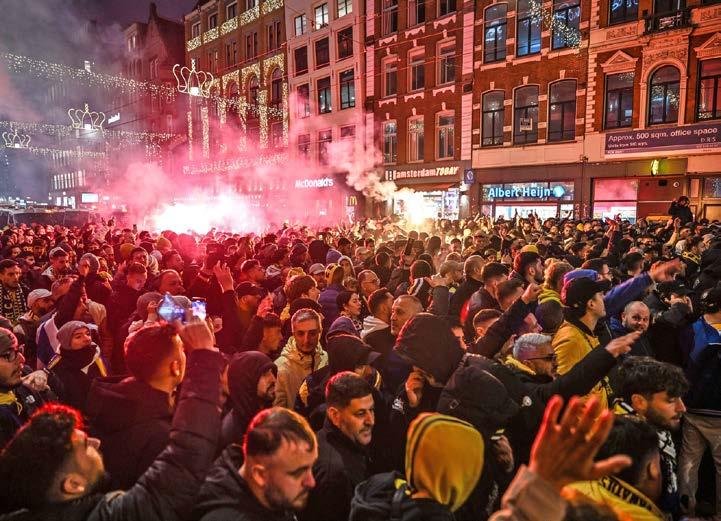
The bad news from Gaza is not going away. But this time Israel will no longer be able to claim as a pretext that the carnage is necessary to “bring home” captives held by Hamas.
Israel’s criminality will be even more starkly on show – and so will Britain’s extensive collusion.
Starmer’s solution has been to furiously pump up fears of “antisemitism,” even if doing so –as with his implicit criticism of the West Midlands Police – makes him and his ministers look ridiculous, incompetent and bad-faith actors.
But there is a logic here – of sorts. The prime minister’s two-fold strategy on Gaza has been evident for a while. On the one hand, Starmer has done the bare minimum to op -
pose Israel’s atrocities, and in the most mealy-mouthed way he can, so he can at least claim, however disingenuously, to be respecting international law.
That is what primarily drove his very belated and grudging recognition of Palestinian statehood, though he appended a raft of nearimpossible conditions to hollow out the move. And it is the rationale for his claimed – but entirely bogus –curbing of UK arms sales to Israel. In fact, Britain has been making record weapons sales to Israel since he became prime minister.
On the other, Starmer has sought to deflect attention from his core policy of inertia on Gaza – designed to keep him onside with Washington – by denouncing any meaning-
ful criticism of Israel as posing a threat to British Jews.
To achieve this, it has been necessary to wildly misrepresent the true source of the antisemitism threat in Britain. Starmer needs to pin the blame for Jew hatred on those who oppose both Israel’s genocidal actions in Gaza and his own complicity in supporting Israel with arms, surveillance intelligence, and rhetorical and diplomatic cover.
That means his main target is the anti-racist left – a left he has been industriously purging from his own Labour Party since he became leader – and Muslim communities that identify most closely with Gaza’s suffering.
Meanwhile, he must distract attention from the real antisemites –
those on the far-right, ranging from sections of the Conservative and Reform parties to an army of white nationalist goons led by Tommy Robinson, a notorious Islamophobe with multiple criminal convictions.
The ultra-right may hate Muslims and Jews equally, but they love the muscular, militarised fortress “Jewish state” of Israel, which prioritises the kind of ethnic purity and anti-Muslim bigotry they would love to see replicated in Britain.
In these circumstances, Starmer’s switch-and-bait has not been easy. Nonetheless, with the media’s backing, he has relentlessly smeared as “antisemites” anti-racists and British Jews – the “wrong sort” – who recoil from a genocide Israel claims it is doing in the name of all Jews.
Meanwhile, he has endorsed the conflation of a genocidal Israel, including its most violent football hooligans, with supposedly “rightthinking” British Jews – that is, those who identify with Israel so strongly they are blind to its crimes.
Starmer now serves as a prominent champion of the hard right’s much-loved “clash of civilisations” thesis, in which a Judeo-Christian West is assumed to be in a life-ordeath, defensive war against a supposedly savage, bloodthirsty Islamic East.
In this narrative, Israel is the rampart against “barbarian Muslim hordes” seeking to storm the citadel of western civilisation.
Naturally, the right brushes aside any other explanation. Such as that Israel’s decades-long meddling in the region and relentless onslaughts on local populations – under the banner of Jewish supremacy, and brazenly as a western client state –may have incited the very response western publics are now encouraged to fear.
Starmer is no less dismissive of the self-sabotaging nature of the West’s foreign policy and its un-
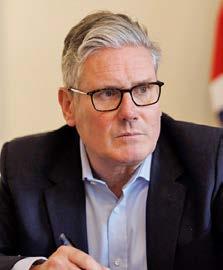
stinting support for Israel, even in the midst of the Gaza genocide.
He cannot countenance the idea that the western-backed slaughter breathes life into assertions – once confined to more extreme groups – that there can be no accommodation with the West. That the West acts in bad faith. That it treats the lives of non-westerners as entirely worthless.
Starmer’s commitment to the “clash of civilisations” worldview was less obvious when he was continuing the previous government’s manufactured fight with “pampered, out-of-touch students” in encampments or “Hamas-sympathising lefties” on anti-genocide marches.
But he has chosen to go further.
He has proscribed as “terrorists” – apparently an upgrade from “antisemites” – the activists of Palestine Action. Their unforgivable sin was to move from street protests to direct action. They sought to put a spoke in the wheels of the British government’s complicity with the genocide, targeting factories in the UK supplying weapons to Israel.
According to Britain’s draconian
Lauren Hurley
terrorism laws, it is also a terrorism offence to show any support for a proscribed organisation.
Starmer appears not to have foreseen that, as a result, the police would be forced to arrest thousands of upstanding citizens – including doctors, lawyers, barristers, retired military officers, and even a former adviser to King Charles.
They have refused to bend to his decree that no debate about the legality, let alone the morality, of Britain arming Israel’s genocide can be tolerated. But now things have turned even darker. Starmer’s current duplicity has led him into siding with violent Israeli football hooligans against his own police force and Muslim communities.
The fallout from his four-square support for Israel’s genocide is that Starmer has had to import more deeply into British domestic politics the inherently divisive “clash of civilisations” ideology. In the process, he has risked revealing how much of a charade his antisemitism narrative has been from the start.
The government’s actions were never really about protecting the Jewish community. Rather, it has been cynically using British Jews as a collective human shield, allowing Starmer to denounce any meaningful criticism of Israel as posing a threat to the Jewish community.
Starmer’s need for a cover story has been especially urgent because he was himself once a distinguished human rights lawyer, one who even served as the lead advocate in a case before the International Court of Justice in 2014 arguing that Serbia had committed genocide in the Croatian city of Vukovar.
How is he to explain his behaviour partnering with Israel and Washington over Gaza’s destruction, when it has required him to shred Britain’s obligations under international law? He cannot claim ignorance, should there come a day when he is brought
before the judges of the International Criminal Court (ICC).
So the story Starmer has been crafting instead is that he is the saviour of Britain’s Jewish community, that he has been charting a difficult course in the face of a supposedly rampant antisemitism from the left, from Muslims, from anti-genocide marchers, from student encampments, from human rights groups, from Holocaust scholars, from the United Nations, from the ICC, and now from the British police.
The over-arching narrative is that Starmer has been one of the key bulwarks against the return of Jew hatred to Europe.
The price required to protect British Jews, so this story goes, has been his role as a “critical friend” to Israel, working behind the scenes to curb its worst excesses, while damping down criticism of Israel that risks inflaming antisemitism.
The main problem for Starmer is that he is being forced to confront more and more groups and institutions to sustain this narrative – to the point where he put himself effectively in a face-off with the British police.
Opponents of the genocide warned from the outset that what started in Gaza could not be contained there. The slaughter would inevitably provoke polarising dissent in the West, require the crushing of basic rights to silence critics of western complicity, and gradually normalise authoritarianism. Starmer’s behaviour has proved just how correct those prognoses were.
The British prime minister’s woes are not about to end, as recent developments demonstrate. Rather, the danger continues to grow of him being charged one day as an accessory to genocide.
Francesca Albanese, the UN’s in-
The UK has done nothing to prosecute British citizens who have chosen to serve on Israel’s side in the Gaza genocide
ternational law expert for the occupied Palestinian territories, helps make that case in a recently report. Entitled Gaza Genocide: A Collective Crime, she highlights the collusion of western states in Israel’s litany of atrocities.
She notes how keen western leaders have been to portray Israel’s onslaught “as a battle of civilisation against barbarism.” In doing so, “they have reproduced the Israeli distortions of international law and colonial tropes, seeking to justify their own complicity in genocide.”
She identifies four sectors where western support has been indispensable in allowing Israel to continue its crimes: diplomatic, military and economic backing, as well as the ideological framing of Israel’s bombing and starvation of Gaza’s people as self-defence, producing a “humanitarian” problem that needs addressing rather than serving as proof of Israel’s genocidal intent.
In this last regard, she specifically names Starmer. In three separate interviews as opposition leader, he claimed that Israel had a “right” to carry through threats to cut off water and power to Gaza’s population.
As she points out, Israel cannot invoke a right to “self-defence” in Gaza under Article 51 of the UN Charter, when it has been holding the enclave’s people under a belligerent, decades-old occupation.
Starmer knows this.
Instead she argues that western leaders like Starmer have echoed the assumptions of a racist, colonial discourse in which non-western-
ers are viewed as “savages” who are undeserving of the protections of international law. That discourse serves to conceal the huge profits western corporations have been reaping by colluding in Israel’s long occupation, as she documented in a previous report.
Western businesses and governments have looked to Israel to use Palestinians as lab rats for testing new surveillance technologies, systems of control and displacement, and killing machines.
These forms of oppression are already being turned against domestic populations in the West.
She points out that Starmer’s government has made the most cursory of nods to international law, such as imposing entry restrictions on two fascist ministers in Netanyahu’s government, while treating other genocide-cheering figures, such as President Isaac Herzog and senior Israeli military officials, as honoured guests.
The UK has been evasive about whether it would enforce the ICC’s arrest warrant against Netanyahu for crimes against humanity – for the starvation of Gaza that Starmer endorsed. And the UK has done nothing to prosecute British citizens who have chosen to serve on Israel’s side in the Gaza genocide, or even dissuade them from participating.
Perhaps most egregiously, a British airbase on Cyprus has served as a crucial supply line for arms to Israel and for hundreds of UK surveillance flights over Gaza.
Albanese observes: “Flight numbers and durations, often coinciding with major Israeli operations, suggest detailed knowledge and cooperation in the destruction of Gaza, extending beyond ‘hostage rescue’.”
The International Court of Justice (ICJ), often known as the World Court, threw its own substantial weight last week behind a verdict that also implicates western leaders
such as Starmer.
It was the court’s third ruling since Israel launched its campaign of slaughter in Gaza two years ago.
The first had found it “plausible” Israel was committing genocide. ICJ judges are currently investigating that charge.
The second ruling, last summer, concluded that Israel’s decades-long occupation and Jewish settlement of the Palestinian territories were illegal; that Israel must immediately withdraw from those territories, including Gaza; and that other states were obligated to put whatever pressure they could on Israel to comply.
Israel has gone in exactly the opposite direction, with its parliament last week voting to formally annex the occupied West Bank.
US Vice-President JD Vance, who was in Israel at the time babysitting Netanyahu to stop him sabotaging the ceasefire, called the parliamen-
Tied to Washington’s apron strings, Starmer, like other western leaders, has made vague noises against Israel’s genocidal Gaza starvation campaign
tary vote a “political stunt” and an “insult.” But the White House’s concern appears to relate chiefly to the timing, which might threaten the ceasefire, rather than the substance.
His replacement, Secretary of State Marco Rubio, who arrived in Israel towards the end of October, stated of the annexation vote: “At this time, it’s something that we … think might be counterproductive.”
Note the conditional “At this time.”
The new, third ruling builds on the second – and hints at the likely outcome of the ICJ’s investigation

of Israel for genocide. It finds Israel’s starvation policy in Gaza – the collective punishment of its population – in flagrant violation of international law.
The World Court justices declare: “The occupying Power may never invoke reasons of security to justify the general suspension of all humanitarian activities in an occupied territory.”
That should serve as a stinging rebuke to Starmer, who, as previously noted, declared that Israel had the right to carry out its declared policy of starving the people of Gaza.
The ICJ also rules that Israel must immediately allow in full supplies of food and aid, and cooperate with Unrwa, the UN aid agency that served as the main lifeline for the people of Gaza until Israel banned its operations last year based on a claim it had been infiltrated by Hamas.
The judges found that Israel had never produced any evidence to support such an allegation.
Israel replaced UN food distribution sites in Gaza with four, hardto-reach “aid hubs” run by a US and Israeli military front group, the wildly misnamed Gaza Humanitarian Foundation. It brought in a trickle of aid while Israeli soldiers regularly sprayed gunfire on desperate Palestinians queueing for food, killing and wounding many thousands.
Trump’s 20-point “peace plan” expressly required of Israel that it allow aid distribution “through the United Nations and its agencies.” And yet on October 24 Rubio changed his administration’s own rules, as well as defying the World Court, by stating that Unrwa could play “no role” in aid distribution because it was supposedly “a subsidiary of Hamas.”
Tied to Washington’s apron strings, Starmer, like other western leaders, has made vague noises against Israel’s genocidal starvation campaign in Gaza, notably after im-
ages of emaciated children came to dominate social media six months ago.
But beyond the optics, he has done nothing substantive to reverse his original support for Israel’s collective punishment of Gaza, its blocking of food, aid and power.
Albanese notes in her new report that, as the Israeli-engineered famine gripped Gaza in the spring, the UK was among a handful of countries that launched operations to parachute aid into the enclave – an operation she describes as “expensive, inadequate and dangerous”.
But even worse, she concludes, the aid drops “only served to mislead international public opinion while the famine worsened.”
When British citizens recently joined an aid flotilla to Gaza, in an attempt to highlight Israel’s illegal naval blockade of the enclave, Starmer pointedly refused to offer them protection, even when they were abducted on the high seas and held in highly abusive conditions in Israel.
Despite Starmer behaving as if Trump’s so-called “peace plan” has ended the “humanitarian crisis” in Gaza, the UN World Food Programme stated that aid deliveries continued to remain well below its daily target of 2,000 tonnes.
The World Health Organisation, meanwhile, has warned that the “health catastrophe” Israel has engineered in Gaza will last for “generations to come.”
Last month the US news show 60 Minutes interviewed Trump’s two pointmen on Gaza: his son-in-law Jared Kushner, and his special envoy Steve Witkoff.
Kushner was keen to highlight how much destruction Israel had unleashed there, explaining that it looked like a nuclear bomb had been
Starmer, like other western leaders, has hitched his wagon to the psychopaths who have been running this two-year horror show
dropped. This appeared to be his clumsy way of underscoring what an achievement Trump had secured in bringing to a halt the orgy of violence – a campaign of destruction, of course, that was made possible only because the US endlessly supplied Israel with armaments.
But with rising panic etched on his face, Kushner could only look on as Witkoff revealed that the pair had been working on a “masterplan” for Gaza’s reconstruction for two years – long before Gaza was levelled by the Israeli military. “Jared has been pushing this,” Witkoff explained.
Analysts have preferred to characterise Trump’s earlier, stated ambition to “clear out” the people of Gaza and build a playground for the rich – a Gaza Riviera – as some kind of hair-brained, improvised response to the scale of the enclave’s devastation.
But Witkoff indicated something even more sinister. That the Trump team had been informed from the outset of Israel’s bombing campaign that the intention was to eradicate Gaza, not Hamas. And so the Trump entourage began working on a business plan to cash in on the carnage.
Gaza, long the western militaryindustrial complex’s laboratory for field-testing weapons and surveillance technology, would now be repurposed as the world’s biggest redevelopment site.
As 60 Minutes’ Lesley Stahl approvingly observed of businessmen Kushner and Witkoff: “Part of the plan is the reconstruction, the building, rebuilding of Gaza. And
you’re builders. You’ve been in real estate.”
The implication from Witkoff’s slip was clear: that what looked like a genocidal ethnic cleansing operation from the start was indeed just that. Trump’s team knew of Israel’s intentions and began putting together deals – both with the oil-rich Gulf states and, according to Witkoff, with Europe too.
The only continuing obstacle are armed resistance movements in Gaza that Washington is determined to disarm.
Starmer, like other western leaders, has hitched his wagon to the psychopaths who have been running this two-year horror show. It is not going away. They are determined to see it out, and reap the financial rewards.
Which means Starmer will have to maintain his “clash of civilisations” cover story and continue miring British politics more deeply in this divisive narrative. That will require further demonising Britain’s ethnic minorities. It will exacerbate the country’s race relations wars. It will deepen the polarisation of British politics. It will lead to an ever-greater hollowing out of fundamental democratic rights. And, ultimately, it will usher in the far right on Farage’s coat-tails.
The legal and ethical earthquake that is the Gaza genocide was never going to be contained in Gaza. Its repercussions are simply too large. As the Maccabi Tel Aviv row demonstrates, the shockwaves for Britain are only going to keep growing louder. CT
Jonathan Cook’s latest books are Israel and the Clash of Civilizations: Iraq, Iran, and the Plan to Remake the Middle East (Pluto Press) and Disappearing Palestine: Israel’s Experiments in Human Despair (Zed Books). His website is www.jonathan-cook.net
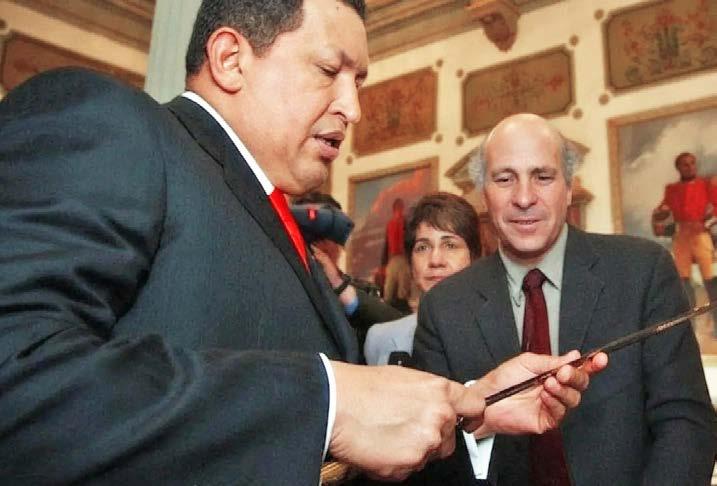
Oil is the real reason for Trump’s desire for ‘covert’ regime change
Imet with Venezuela’s President Hugo Chavez just days after he was kidnapped. I’ll tell you about that, and the current President Nicolas Maduro’s visit to my New York office. But first, you must know three things about Venezuela to understand why Donald Trump has ordered a covert operation to overthrow their government.
1. Venezuela has the largest reserves of oil on the planet.
2. Venezuela has the largest reserves of oil on the planet.
3. Venezuela has the largest reserves of oil on the planet.
Look it up: According to OPEC’s own site, Venezuela’s 303 billion barrels in proven reserves are four
times the reserves of Saudi Arabia.
(By the way, Donald, when you announce a “covert” operation, it’s no longer covert. But never mind.)
For years, I was BBC Television’s correspondent covering Venezuela and US attempts to overthrow their elected government. Trump invented nothing. This is at least the fourth US-backed attempt at over-
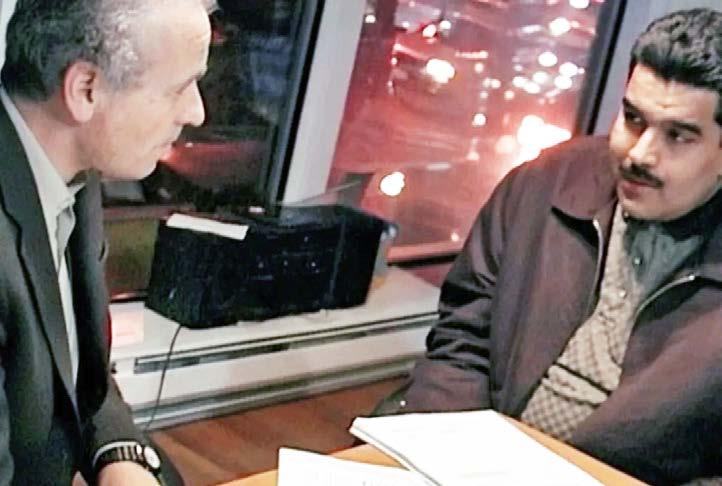
throw and assassination of a Venezuelan president.
The first attempt was in March 2002 when I was tipped off that Chavez would be overthrown in a military coup. Indeed, in April of that year, he was kidnapped by renegade officers who had the fantasy, shared by the US State Department, that the public hated Chavez and would celebrate his overthrow.
But it turned into another Bay of Pigs after tens of thousands of angry Venezuelans surrounded Miraflores Palace while the coup leaders “inaugurated” Exxon Oil’s lawyer as President, George W. Bush’s Ambassador to Venezuela attended this wacky inauguration of the faux president.
But then the plotters, with Exxon’s man and the US Ambassador,
fled the Presidential Palace after the coup leaders, fearing for their lives, returned Chavez by helicopter safely to his Oval Office.
I met days later with Chavez, who told my BBC audience that while in the helicopter he clutched his rosary because he expected to be pushed out into the sea.
Instead, he was returned safely by the frightened coup leaders back to his office. Chavez then chose to let his kidnappers escape without punishment.
In 2004, Nicolas Maduro, the future president, was sent by Chavez to meet me at my office in New York to review the evidence that Wackenhut Corporation (now called GEO,
a major operator of ICE detention centres) had planned to assassinate Chavez.
Venezuelan intelligence had secretly taped US Embassy contractors in Caracas talking in spookspeak: “That which took shape here is a disguised kind of intelligence… which is annexed to the third security ring, which is the invisible ring.” (Invisible Ring? Someone at the State Department has read too many John le Carré novels.)
The State Department under George W. Bush also tried to purge voters from Venezuela’s election files (and those in Argentina and Mexico) using the very same company, Choicepoint Inc., that purged voter files in Florida in 2000 to hand Bush his baloney election “victory.”
Third try: During Trump I, the US
attempted to bully Venezuelans into electing a white guy named Juan Guaidó (who lived in the US), whom Trump hoped would defeat Maduro in an election. But the Black and Indian population of Venezuela, were not going back to white minority rule which had crushed them for 400 years. Guaidó never even ran for President, but the US government, nevertheless, declared him the true President and gave this grifter all the US assets of CITGO, the Venezuelan oil company.
Today, we are at the fourth attempt to overthrow Venezuela’s government by kidnap (again?!) or assassination.
This time is different. Because President Maduro really did lose his third re-election bid for the presidency. But he simply refused to leave office. (Hey, you’d think Trump would admire that.)
No question, Maduro has become a dictator. But, if the US thinks it can invade Venezuela, or appoint Maduro’s replacement, you don’t know Venezuelans. They are patriots and they are all armed. How many Americans will Trump send to their deaths to get his hands on Venezuelan crude?
The saddest thing is that Maduro has corrupted and destroyed the robust democracy that Chavez brought to Venezuela.
In 2006, I joined Chavez’s opponent Julio Borges on the campaign trail. A decent guy, Borges would get just two or three supporters in a town. Then I joined Chavez who, in the same town, would appear and draw thousands.
Chavez was wildly popular because, as an opposition journalist told me, derisively, “Chavez gives them bread and bricks!” – that is, he gave the public food, housing and medical care by using the na-
After these little commuter boats were attacked, not sunk, we were never shown the drugs, the evidence
tion’s massive oil proceeds for public services. Under the old regime, the oil wealth was siphoned into the pockets of wealthy Venezuelans in Miami.
I have little sympathy for Maduro, who like Trump, took office through vote manipulation. But the invasion or assassination of either head of state should scare and horrify us all.
Trump and our National Security Advisor Marco Rubio have said that Maduro must go because he has threatened democracy in Venezuela and is trafficking fentanyl into the US.
Think about it. If Trump wants to save democracy, why attack Venezuela, not the dictatorships of Saudi Arabia or Abu Dhabi or the Emirates? Let’s not forget that Arabian Peninsula “royals” are merely dictators in bathrobes.
Why Venezuela and not the Arabian Peninsula potentates? Let me count the ways: Qatar has bought $2 billion of Trump crypto coins that will go into Trump family pockets. And there’s that little gift from Qatar of a 747 jet for The Donald, not the US government. And there’s the $2 billion in easy squeezy from the Saudis for Jared Kushner.
Trump has accused Maduro of running a cartel dumping fentanyl into the US, an accusation as credible as Trump’s claim against that other alleged narco-terrorist nation, Canada.
I am no fan of my once-friend Maduro. But drug lord? No sane drug dealer would run drugs from Caracas to Miami. In fact, according to
the latest UN World Drug Report, Venezuela is neither a major drug producer nor a key trafficking corridor to the US.
Trump’s troops have slaughtered more than two dozen people who were supposedly running drugs from Caracas to Miami. While Trinidad’s president is a Trump ally, that government stated that Chad Joseph and Rishi Samaroo, the two dead who could be identified, were simply commuting from work, like many workers, across the 7-mile strait between the countries. Even US Secretary of State, “Little Marco,” said the boat was merely heading to Trinidad when he changed his statement to “Miami” after Trump announced their supposed destination.
And did you notice? Every time a US prosecutor interdicts a drug shipment, they proudly display the drugs and cash, and the names of the dealers obtained in the haul. Yet after these little commuter boats were attacked, not sunk, we were never shown the drugs, the evidence.
There was indeed a drug boat, a submersible, attacked by the US. But American media generally failed to mention that, unlike the fishermen and commuters killed coming from Venezuela, the one real drug haul came from Colombia and was captured in the Pacific Ocean, not the Caribbean.
So where are the drugs coming from, if not Venezuela or Canada? According to a New Yorker investigation, one of the world’s largest and most violent cocaine cartels, the Kinahan Organized Crime Group, is run out of – you guessed it – Abu Dhabi.
There’s no doubt why most Venezuelans want to see Maduro go. The economy is on its deathbed. Why? Because a US blockade, basically a siege of Venezuela, has caused the near total collapse of

Venezuela’s source of wealth – its oil industry. By blocking oil equipment from going in, and an embargo of oil going out, the nation is being strangled. An embargo is a globally recognised act of war which Americans (let alone Venezuelans) never authorised.
The idea that Maduro wrecked the economy is bullshit through and through. Imagine if America laid siege to Texas, allowing no goods in, blocking oil from going out. Nevertheless, the public, hoping the embargo would lift, voted out Maduro. He didn’t go.
And let me tell you as an energy economist, that the embargo of Venezuelan oil, cutting the nation’s exports 74 percent from 2.4 million barrels a day to 735,000, has easily added nearly a dollar to the price paid by Americans at the gas pump.
Chavez told me that he knew the limit of how far he could push the US
and its oil companies. “I’m a good chess player,” he told me. Not Maduro. For example, Maduro turned down British Petroleum’s request to take over the oil fields once operated by the French national oil company. Britain later seized $10 billion in Venezuela’s gold reserves held in the British Exchequer.
As you’ll see at the opening of my film, The Assassination of Hugo Chavez, the whack-o idea of murdering Venezuela’s president was first floated on television by none other than televangelist Pat Robertson, whom inside sources told me was furious that he was turned down in his request to Chavez government for a diamond mining concession.
To his TV audience, Robertson said, “You know, I don’t know about this doctrine of assassination, but if
[Chavez] thinks we’re trying to assassinate him, I think that we really ought to go ahead and do it. It’s a whole lot cheaper than starting a war.”
That’s true, I suppose. But why start a war at all? Oil and diamonds. How much blood are they worth?
May I suggest that we return democracy to Venezuela with ballots, not bullets. CT
Greg Palast (Rolling Stone, Guardian, BBC) is the author of the New York Times bestsellers, Armed Madhouse, Billionaires & Ballot Bandits and the book and documentary, The Best Democracy Money Can Buy His latest film is Vigilantes Inc: America’s New Vote Suppression Hitmen. Palast is currently working on a new documentary Long Knife, exposing the Koch Brothers’ theft of Osage oil, to be released later this year.
Watch the film of Greg Palast’s BBC reports, The Assassination of Hugo Chavez, produced with Oscar-nominated cinematographer Richard Rowley at www.youtube.com/watch?v=syExbfVPDnU
➤ VIJAY PRASHAD
Catherine Connelly promises to be the voice of the working class and the oppressed – not rich landlords and bankers
Catherine Connolly (born in 1957) only became involved in active politics in 1999, when Michael D. Higgins, the outgoing president of Ireland (2011-2025), encouraged her to join the Labour Party and stand for election.
Both Connolly and Higgins (known in Ireland as Michael D) come from Galway, a city on the west coast of Ireland. Connolly was born there, the ninth of 14 children – seven girls and seven boys – in a working-class family. Her mother died when Catherine was nine, and her father, a home builder, relied on his older children to care for the younger ones.
In this household, Catherine Connolly developed a keen sense of service and discipline, which included involvement in local Catholic charities such as the Legion of Mary and the Order of Malta. This was, as she describes it, Connolly’s road to “her socialism.”
As a lawyer in Galway with a young family (two boys), Connolly ran for and won a seat on the Galway City Council in 1999, later becoming Mayor of Galway from 2004 to 2005. Michael D had been Mayor from 1990 to 1991. Just as she followed him to City Hall, Connolly has now followed Michael D to the presidency of Ireland.
Ireland is a country divided by
British colonialism: most of the population lives in the Republic of Ireland (population 5.2 million), while a part of the island’s population lives in the northern counties still controlled by the United Kingdom (population 1.5 million).
There are between 50 million and 80 million people around the world, mostly in the Americas, who claim Irish descent (the most famous person, now featured on an Irish stamp, was Che Guevara).
Half the population in the six northern counties have Irish citizenship (while there are nearly three million diaspora Irish with citizenship), making them eligible to vote for the president.
While the president represents the Republic – and even then, in a largely ceremonial role – the post has been shaped by its previous nine holders as a pulpit from which to speak for all of Ireland.
Michael D, a poet as well as a politician, transformed the post, shaping it into a moral lectern from which to advocate for Ireland’s role in the world based on larger values. This is a post that Catherine Connolly will undoubtedly enjoy.
Both Catherine Connolly and Michael D are unabashedly left-wing, absorbed by the struggle for people to live with dignity in Ireland itself and gripped by severe global chal-
lenges, particularly those posed by US imperialism.
Connolly first entered politics 26 years ago because of the housing crisis, the ‘defining social crisis of our time.’
This remains the most important problem for young people in Ireland, many of whom find it impossible to rent decent accommodation near their places of work.
In the 1990s, Ireland’s economy boomed through the liberalisation of finance, earning the country the nickname ‘Celtic Tiger’ (a phrase first used by a Morgan Stanley analyst). A low corporate tax rate and membership in the European Union allowed the country to attract tech money and real estate investment. This drove up housing prices, which have not collapsed despite the bust of the Celtic Tiger after the 2008 credit crisis (Ireland suffered a similar fate as Iceland, but with less prison time for its own banking elite).
It is estimated that the country suffers a housing shortage of a quarter of a million units, that a new teacher in Dublin would have to use their entire salary to pay rent for a modest apartment, and that while wages rose at 27 percent between 2012 and 2022, property prices in-

creased by 75 percent.
Connolly spent most of her campaign focused on the direct problems faced by the Irish people, although the presidency can only lift issues into the public debate and advise the elected government.
When I visited Michael D in the presidential residence in 2014, he was gripped by the waste of human resources on war and war-making to the exclusion of solving problems of human life. He was interested in why so much of social wealth was being spent on warfare, when it was clear that war-making (such as with the US War on Terror) merely created more problems than it solved.
We discussed the issue of Irish neutrality and how Ireland had slipped from that core principle by allowing the US permission to land warplanes and CIA planes at Shannon airport, the closest airport to Galway.
Connolly will follow Michael D into the presidential office with this same concern. She has made vital statements not only against US warmaking, but against the Israeli genocide of the Palestinians. In June, Connolly called Israel a “terrorist state.” It is likely that these sorts of statements will continue to be made from Dublin.
Since Éamon de Valera won the prime ministership in 1932 as the leader of Fianna Fáil (the Republican Party), the country has been led back and forth by Fianna Fáil
and Fine Gael (the Irish Party). Both are now parties of the right (with close links to the political elite in the United States) and have, since 2020, been in a grand alliance for the prime ministership.
Connolly ran against Fine Gael’s Heather Humphreys, who put up a very poor show. Though running as “independent.” Connolly was backed by the broad left: 100 percent Redress, the Communist Party of Ireland, the Green Party, the Labour Party, People Before Profit, Sinn Féin, the Social Democratic Party, and the Workers Party, as well as a raft of organisations and movements.
The backing of Sinn Féin, the second largest party in parliament, was crucial; the party brings to bear the weight of the republican tradition, which is focused on the unification of Ireland, and the weight of the party’s working-class roots in the cities where the housing question is paramount.
While Connolly has said that she will represent the entire country, she will be largely the voice of the working-class and the oppressed — not the Irish landlords and bankers. Nor will she be kind to US imperialism and its allies. CT
Vijay Prashad is an Indian historian, editor, and journalist. He is a writing fellow and chief correspondent at Globetrotter. He is an editor of LeftWord Books and the director of Tricontinental: Institute for Social Research. His latest books are On Cuba: Reflections on 70 Years of Revolution and Struggle (with Noam Chomsky), Struggle Makes Us Human: Learning from Movements for Socialism, and (also with Noam Chomsky) The Withdrawal: Iraq, Libya, Afghanistan, and the Fragility of US Power. This article was written by Globetrotter.
➤ JOHN & NISHA WHITEHEAD
In declaring “Antifa” – a loose ideology based on opposition to fascism –as a domestic terrorist organisation, the US government has given itself a green light to treat speech, belief, and association as criminal acts
“Those who created this country chose freedom. With all of its dangers. And do you know the riskiest part of that choice they made? They actually believed that we could be trusted to make up our own minds in the whirl of differing ideas. That we could be trusted to remain free, even when there were very, very seductive voices – taking advantage of our freedom of speech – who were trying to turn this country into the kind of place where the government could tell you what you can and cannot do.”
– Nat Hentoff
The Trump administration is taking its war on free speech into the realm of thought crimes. This is more than politics.
In declaring “Antifa” – a loose ideology based on opposition to fascism – as a domestic terrorist organisation, the government has given itself a green light to treat speech, belief, and association as criminal acts. With this one executive order, political dissent has been rebranded as terrorism and free thought recast as a crime.
Critics will argue that “Antifa” means rioting and property destruction. But violent acts are already crimes, handled under ordinary
law. What’s new – and dangerous –is punishing people not for violence, but for what they believe, say, or with whom they associate. Peaceful protest, political speech, and nonviolent dissent are now being lumped together with terrorism.
Violence should be prosecuted. But when peaceful protest and dissent are treated as terrorism, the line between crime and thought crime disappears.
When the government polices political belief, we’re no longer talking about crime – we’re talking about thought control.
This opens the door to guilt by association, thought crimes, and McCarthy-style blacklists, making it possible for the government to treat peaceful protesters, critics, or even casual sympathisers as terrorists. Protesters who identify with antifascist beliefs – or who, under this administration, simply challenge its power grabs and overreaches – can now be surveilled, prosecuted, and silenced, not for acts of violence but for what they think, say, or believe.
Under this executive order, George Orwell – the antifascist author of 1984 – would become an enemy of the state.
This is how dissent becomes labelled as “terrorism” in a police state: by targeting political thought instead of criminal conduct.
Once you can be investigated and punished for your associations or sympathies, the First Amendment is reduced to empty words on paper.
Nor is this an isolated development. It is part of a larger pattern in which the right to think and speak freely without government interference or fear of retribution – long the bedrock of American liberty –is treated as a conditional privilege rather than an inalienable right, granted only to those who toe the official line and revoked from those who dare dissent.
The warning signs are everywhere.
The Pentagon now requires reporters to pledge not to publish “unauthorised” information. Broadcasters silence comedians after political outrage. Social media platforms delete or deplatform disfavoured viewpoints.
The common thread running through these incidents is not their subject matter but their method.
Government officials don’t need to pass laws criminalising dissent when they can simply ensure that dissent is punished and compliance rewarded.

The result is a culture of selfcensorship.
The First Amendment was written precisely to prevent this kind of chilling effect. The US Supreme Court has long recognised that speech does not lose protection simply because it is offensive, controversial, or even hateful.
Yet today, by redefining unpopular expression as “dangerous” or “unauthorised,” government officials have come up with a far more insidious way of silencing their critics.
In fact, the Court has held that it is “a bedrock principle underlying the First Amendment … that the government may not prohibit the expression of an idea simply because society finds the idea offensive or disagreeable.” It is not, for example, a question of whether the Confederate flag represents racism but whether banning it leads to even greater problems – namely, the loss of freedom in general.
Along with the constitutional right to peacefully (and that means non-violently) assemble, the right to free speech allows us to challenge the government through protests and demonstrations and to attempt to change the world around us – for the better or the worse – through protests and counterprotests.
If citizens cannot stand out in the open and voice their disapproval of their government, its representatives, and its policies without fearing prosecution, then the First Amendment – with all its robust protections for speech, assembly, and petition –is little more than window dressing: pretty to look at, but serving little real purpose.
Living in a representative republic means that each person has the right to take a stand for what they think is right – whether that means marching outside the halls of gov-
ernment, wearing clothing with provocative statements, or simply holding up a sign.
That is what the First Amendment is supposed to be about: assuring the citizenry of the right to express their concerns about their government, in the time, place, and manner best suited to ensuring those concerns are heard.
Unfortunately, through a series of carefully crafted legislative steps and politically expedient court rulings, government officials have managed to disembowel this fundamental freedom, rendering it little more than the right to file a lawsuit against those in power.
In more and more cases, the government is declaring war on what should be protected political speech whenever it challenges authority, exposes corruption, or encourages the citizenry to push back against injustice.
The machinery of censorship is more entrenched than ever.
With growing monopolies of the media, a handful of corporate gatekeepers dominate the digital public square. Government regulators hold powerful levers – licenses, contracts, antitrust threats – that can be used to manipulate content so that only what is approved is publicised. And a public increasingly conditioned to equate harm with offence becomes an unwitting accomplice to suppression, cheering the silencing of adversaries without realising that the same tools will be used against them tomorrow.
This crackdown on expression is not limited to government action.
Corporate America has now taken the lead in policing speech online, with social media giants such as Facebook, Twitter, and YouTube using their dominance to censor, penalise, and regulate what users can say. Under the banner of “community standards” against obscenity, violence, hate speech, or intolerance, they suspend or ban users whose content strays from approved orthodoxy.
Make no mistake: this is fascism, American-style.
As presidential advisor Bertram Gross warned in Friendly Fascism: The New Face of Power in America, “Anyone looking for black shirts, mass parties, or men on horseback will miss the telltale clues of creeping fascism. . . . In America, it would be super modern and multi-ethnic – as American as Madison Avenue, executive luncheons, credit cards, and apple pie. It would be fascism with a smile. As a warning against its cosmetic façade, subtle manipulation, and velvet gloves, I call it friendly fascism. What scares me most is its subtle appeal.”
The appeal here is the self-righteous claim to be fighting evils – hatred, violence, intolerance – using
By labelling a loose ideology as terrorism, the government opens the door to treat political opposition as criminal conspiracy
the weapons of Corporate America. But those weapons are easily redirected. Today they are aimed at “hate.” Tomorrow they will be aimed at dissent.
The effect is the same: the range of permissible ideas shrinks until only government-approved truths remain. Combine this with Trump’s Antifa executive order, and the danger becomes unmistakable.
By labelling a loose ideology as terrorism, the government opens the door to treat political opposition as criminal conspiracy. Combine that with corporate censorship, and the result is chilling. Together, they create a chokehold on dissent.
The Constitution’s promise of free speech becomes little more than words on paper if every outlet for expression – public or private – is policed, monitored, or denied.
“Free speech for me but not for thee” is how my good friend and free speech purist Nat Hentoff used to sum up this double standard.
We have entered an era in which free speech has become regulated speech: celebrated when it reflects the values of the majority, tolerated when it doesn’t, and branded “dangerous” when it dares to challenge political, religious, or cultural comfort zones.
President Trump, who regularly mocks critics while trying to muzzle those who speak out against him, may be the perfect poster child for this age of intolerance. Protest laws, free speech zones, bubble zones, anti-bullying policies, hate-crime statutes, zero-tolerance rules – these
legalistic tools, championed by politicians and prosecutors across the political spectrum, have steadily corroded the core freedom to speak one’s mind.
The US government has become particularly intolerant of speech that challenges its power, reveals its corruption, exposes its lies, and encourages the citizenry to push back against its many injustices.
Indeed, there is a long and growing list of the kinds of speech that is being flagged, censored, surveilled, or investigated by the government: “hate speech,” “intolerant speech,” “conspiratorial speech,” “treasonous speech,” “incendiary speech,” “anti-government speech,” “extremist speech,” and more.
By rebranding dissent as dangerous speech, government officials have given themselves the power to police expression without judicial oversight. This is not a partisan issue. Under one administration, speech may be stifled in the name of fighting “misinformation.” Under another, it may be curbed in the name of rooting out “dangerous” or “hateful” speech.
The justifications change with the politics of the moment, but the outcome is the same: less speech, narrower debate, and more fear. The stakes could not be higher. If we no longer have the right to tell an ICE agent to get off our property, to tell a police officer to get a search warrant before entering our home, to stand outside the Supreme Court with a protest sign, to approach an elected representative to share our views, or if we no longer have the right to voice our opinions in public – no matter how offensive, intolerant, or politically incorrect – then we do not have free speech.
Just as surveillance stifles dissent, government censorship gives rise to self-censorship, breeds compliance, smothers independent thought, and fuels the kind of frus-
tration that can erupt in violence.
The First Amendment is meant to be a steam valve: allowing people to speak their minds, air grievances, and contribute to a dialogue that hopefully results in a more just world. When that valve is shut –when there is no one to hear what people have to say – frustration builds, anger grows, and society becomes more volatile.
Silencing unpopular viewpoints with which the majority might disagree – whether by shouting them down, censoring them, or criminalising them – only empowers the Deep State. The motives –discouraging racism, condemning violence, promoting civility – may sound well-intentioned, but the result is always the same: intolerance,
Silencing unpopular viewpoints with which the majority might disagree only empowers the Deep State
indoctrination, and infantilism.
The police state could not ask for better citizens than those who do its censoring for it.
This is how a nation of free people becomes an extension of the surveillance state, turning citizens against each other while the government grows stronger.
The path forward is clear.
As Justice William O. Douglas wrote in his dissent in Colten v. Kentucky, “we need not stay docile and quiet” in the face of authority.
The Constitution does not require Americans to be servile or even civil to government officials.
What is required is more speech not less – even when it offends. It’s time to make the government hear us – see us – and heed us.
This is the ultimate power of free speech. CT
John W. Whitehead is a constitutional lawyer and founder and president of the Rutherford Institute. His most recent books are the award-winning A Government of Wolves: The Emerging American Police State, and a novel, The Erik Blair Diaries. Whitehead can be contacted at staff@rutherford.org.
Nisha Whitehead is the Executive Director of The Rutherford Institute. Information about The Rutherford Institute is available at www.rutherford.org
Peter Caton, an award-winning British photographer has dedicated his career to reporting on humanitarian causes and amplifying the voices of disadvantaged people. He has lived on the road for 19 years, the last ten in Africa, where he has documented climate-related crises throughout the continent.
In Unyielding Floods, he photographs villagers in South Sudan as they struggle to protect their homes and livelihoods against catastrophic floods. Over four years, Peter returned to this historic land, capturing the struggles of the villagers, their resilience and their heartache.
£40.00 (hardback} 120 pages | 80 duotone plates

➤ SHANE M c CORRISTINE
A knotty question that has baffled (some) philosophers for centuries
When you think of a ghost, what comes to mind? A ghastly, mouldy windingsheet? A malevolent pile of supernatural armour? Or a sinister gentleman in a stiff Victorian suit?
In 1863 George Cruikshank, the caricaturist and illustrator of Dickens’s novels, announced a “discovery” concerning the varied appearance of ghosts. It does not seem, he wrote:
“That any one has ever thought of the gross absurdity and impossibility of there being such things as ghosts of wearing apparel … Ghosts cannot, must not, dare not, for decency’s sake, appear without clothes; and as there can be no such thing as ghosts or spirits of clothes, why then, it appears that ghosts never did appear and never can appear.”
Why aren’t ghosts naked? This was a key philosophical question for Cruikshank and many others in Victorian Britain. Indeed, stories of naked or clothesless ghosts, especially outside folklore, are exceedingly rare. Sceptics and ghostseers alike have delighted in thinking about how exactly ghosts could have form and force in the material world. Just what kind of stuff could they be made of that allows them to share our plane of existence, in all
its mundanity?
The image of the ghost as a figure in a white winding-sheet or burial shroud has retained its iconic status for hundreds of years because it suggests a continuity between the corpse and the spirit.
The main social role of the ghost before the modern period was to carry a message to the living from beyond the grave, so the link to burial clothing makes sense. This can be seen in the medieval trope of the Three Living and the Three Dead, whereby some hunters encounter their future skeletal corpses, wrapped in linen, admonishing them to remember death.
Yet by the mid-19th century, with spiritualism and early forms of psychical research spreading across the western world, people began to report seeing ghosts dressed in everyday and contemporaneous clothing.
This raised problems for those interested in investigating the reality of ghosts. If the ghost was an objective reality, why should it be wearing clothes? If the tenets of spiritualism were true, should the soul which has returned to visit the earth not be formed of light or some other form of ethereal substance? Were the clothes of spirits also spiritual, and if so, did they share in their
essence or were they the ghosts of clothes in their own right?
You could adopt an idealist position and say that the clothes were metaphysical ideas bound up with the immortal identity of the wearer – the identity of the ghost meaning something more than simply the apparition of a soul-force.
Another explanation was that ghost-seers dress the ghost, automatically, through unconscious processes. And so we see a ghost in its usual dress because that is the mental picture we have of the person, and this choice of garment is most likely to inspire recognition.
The critic and anthropologist Andrew Lang drew comparisons between dreaming and ghost-seeing in 1897 when he stated that:
“We do not see people naked, as a rule, in our dreams; and hallucinations, being waking dreams, conform to the same rule. If a ghost opens a door or lifts a curtain in our sight, that, too, is only part of the illusion. The door did not open; the curtain was not lifted … It was produced in the same way as when a hypnotised patient is told that ‘his hand is burned,’ his fancy then begets real blisters.”
For Lang, the clothes of ghosts were the stuff that dreams are made of. The implication of this, that ghost-seers are dressers, but not undressers, seems to reflect a per-



vading morality of ghosts, whereby most 19th-century spirits were sanitised and chaste. Lang’s odd assumption that there was no nakedness in dreams echoes this.
Fashion and clothing were central to the identification of class, gender and occupation in the Victorian period. The ghosts of the servant class seemed to be especially tied to their clothes, rather than their faces or voices – a theme that comes out in some ghost reports submitted to The Strand magazine in 1908.
Here, a ghost-seer reported seeing “a figure, which had nothing super-
natural about it, being simply that of a servant in a light cotton dress … and with a white cap on … The whole figure had the general appearance of the housemaid, so that she had been the one I had thought of. It was not in the least like the cook, who dressed in much darker cottons”.
Clothes identify people and make them capable of representation –nakedness disrupts this means of instantly categorising someone.
The issue of ghost clothes is interesting for historians of the supernatural because, like a loose thread, pulling at it starts to unravel some of the assumptions about matter in spiritualism. Do ghosts retain the injuries or disabilities that befell them in life? And what about the erotic
fleshiness of spirits – the touching and kissing between the living and the dead in the séance room and the “ectoplasm” (a gauze-like spiritual substance) photographed emerging from the orifices of mediums? Could the living even have sexual intercourse with ghosts?
These kinds of knotty debates have not disappeared in the 21st century. Indeed, “spectrophilia” – or the love of ghosts – is a fetish that is a lively topic of debate on the internet today. Another turn of the screw in the long history of how spirits matter in the world of the living. CT
Shane McCorristine is Reader in Cultural History, at Newcastle University in England. This article was first published in The Conversation at www.theconversation.com
